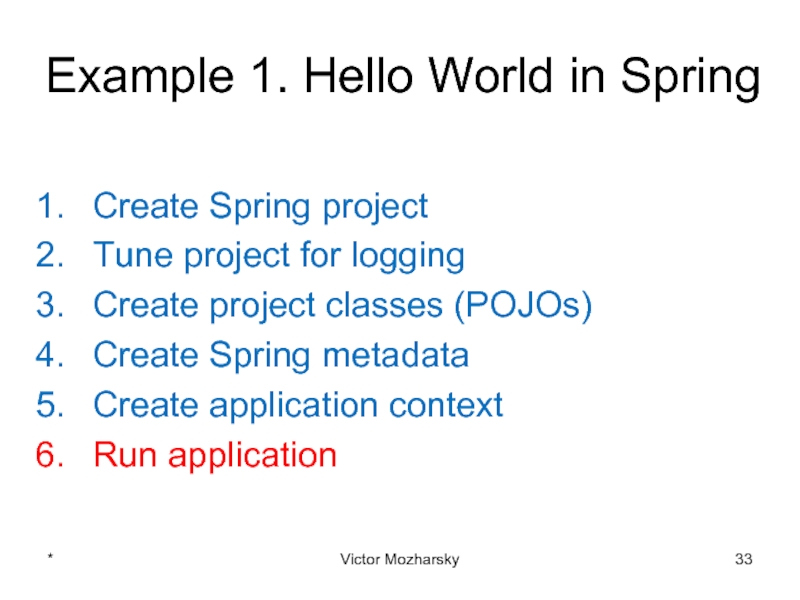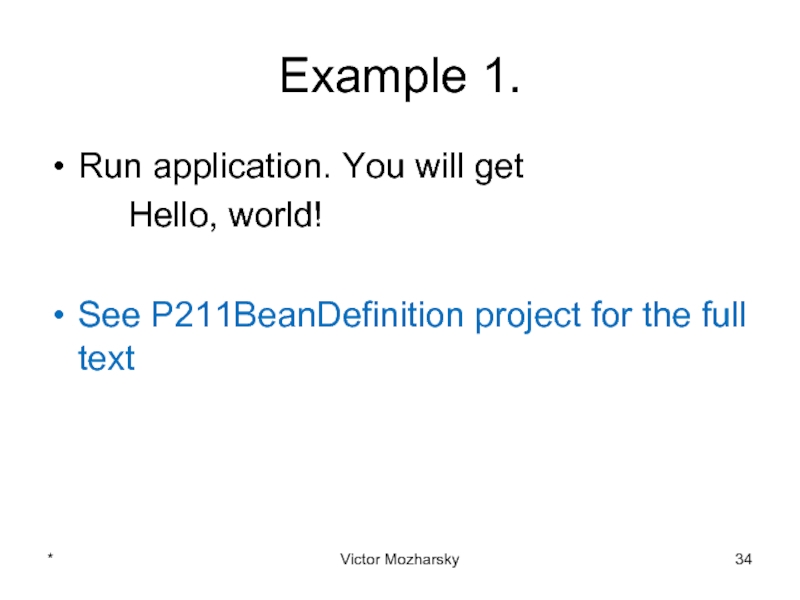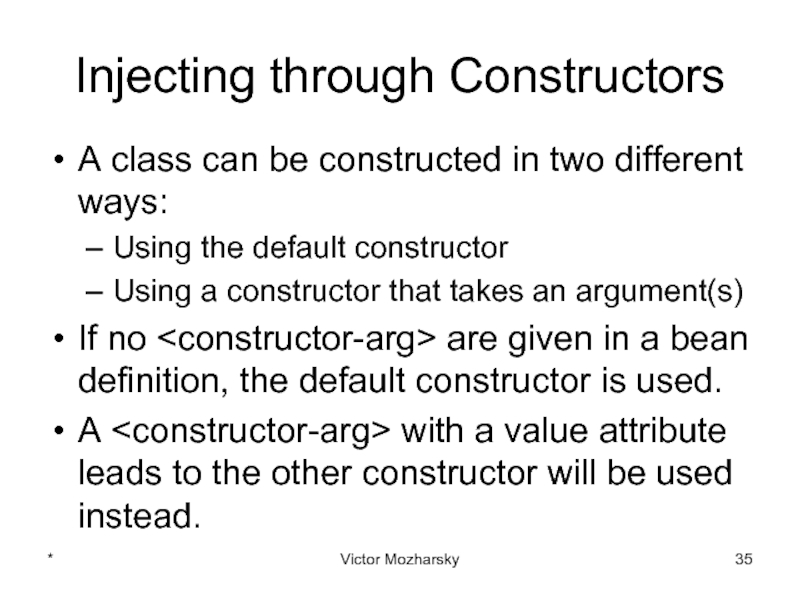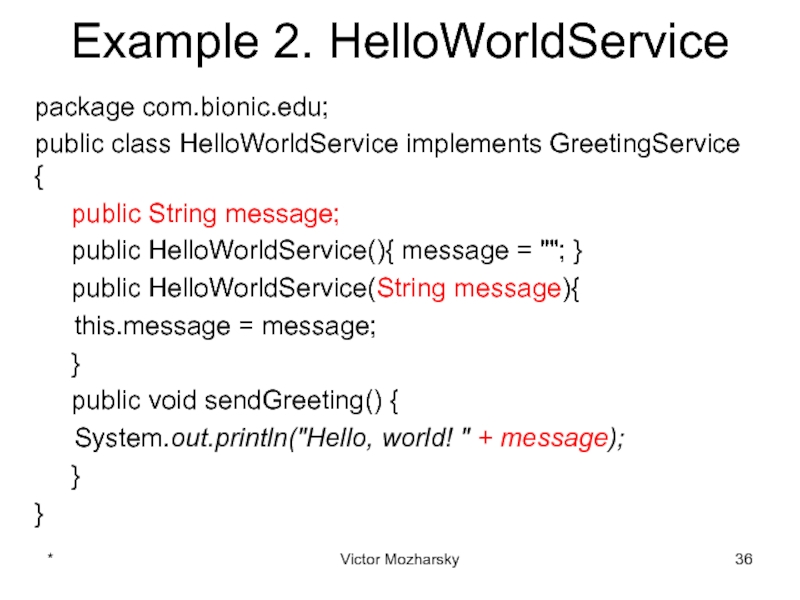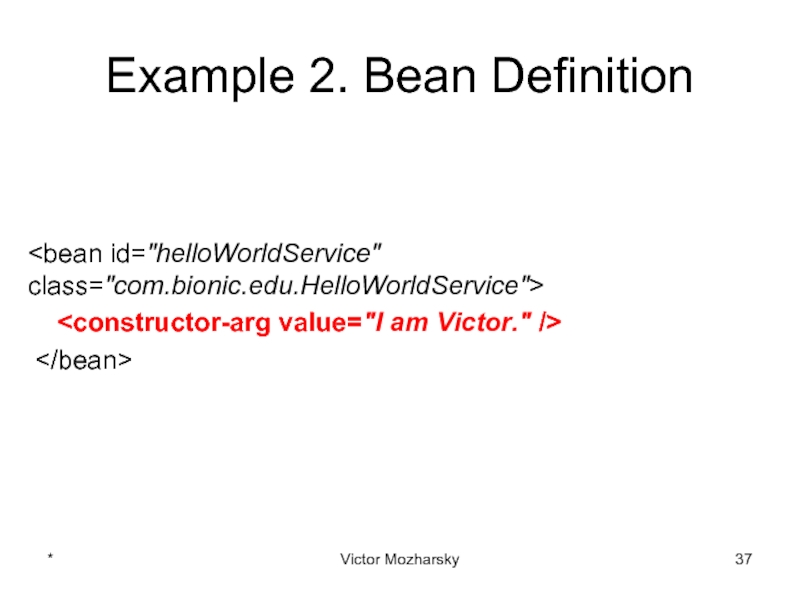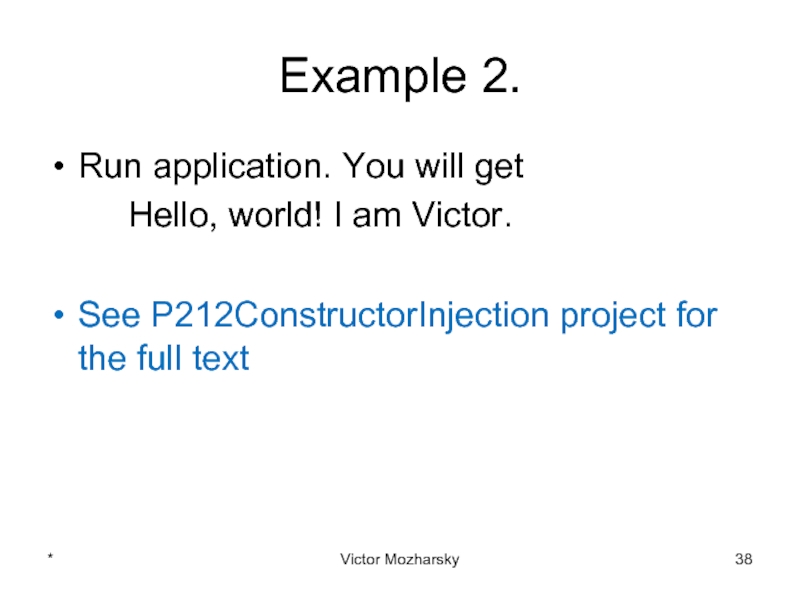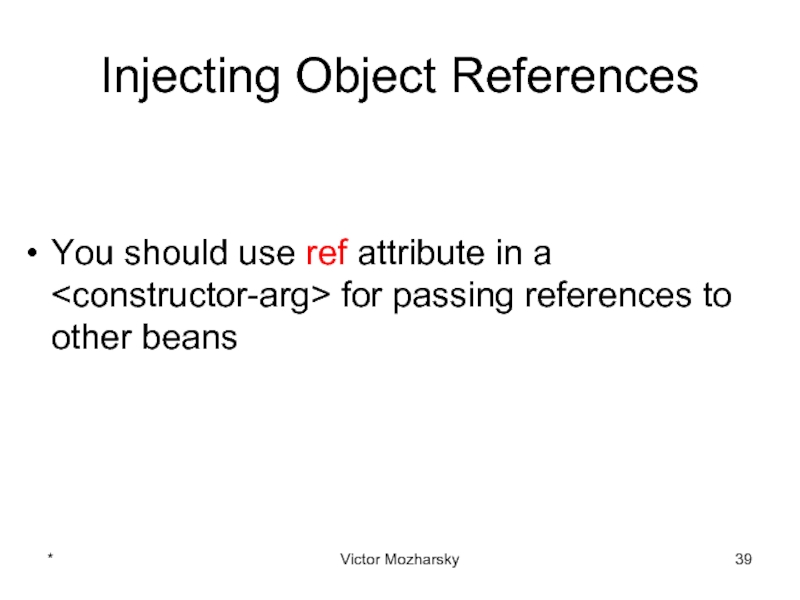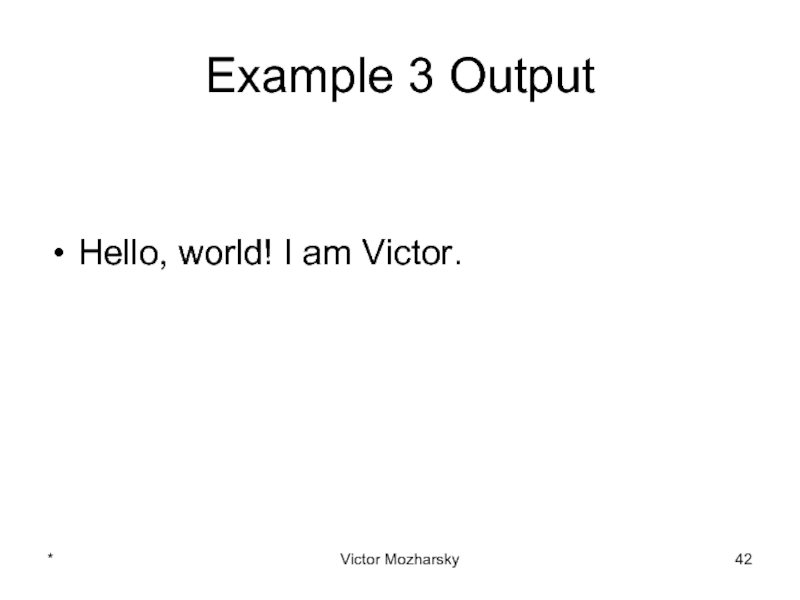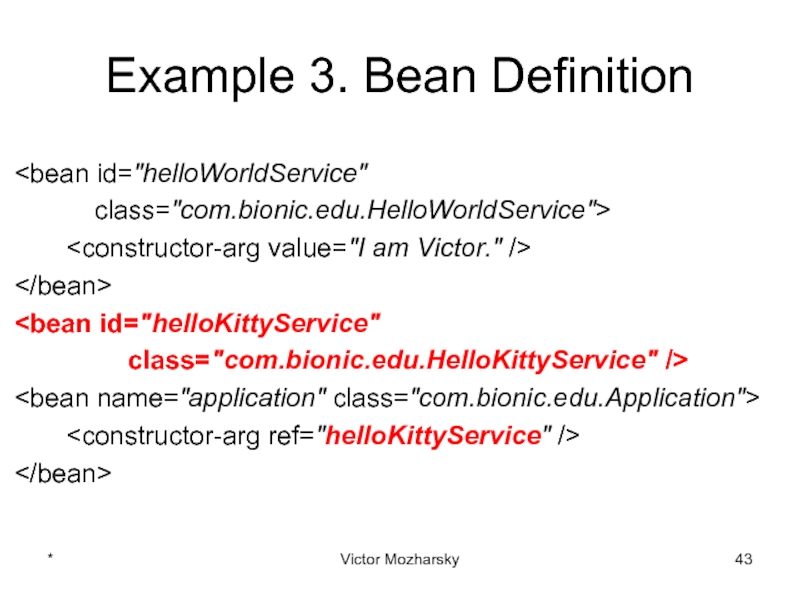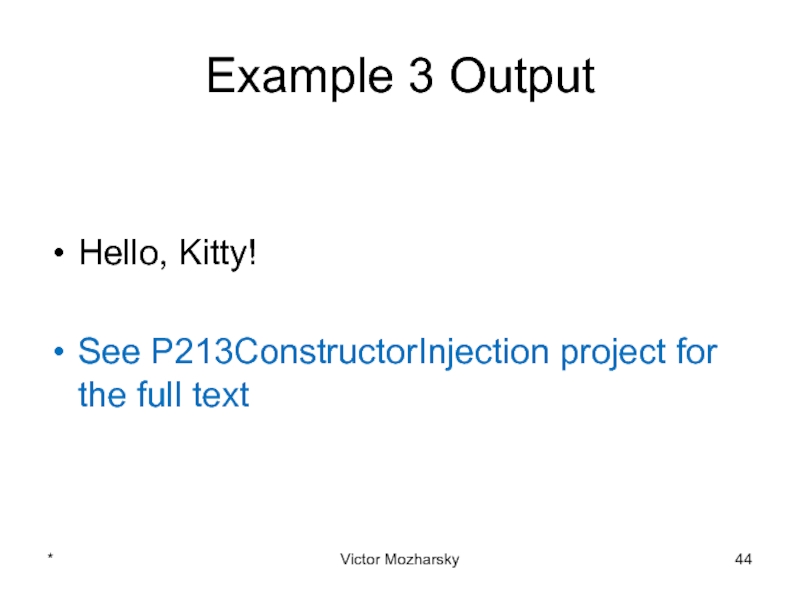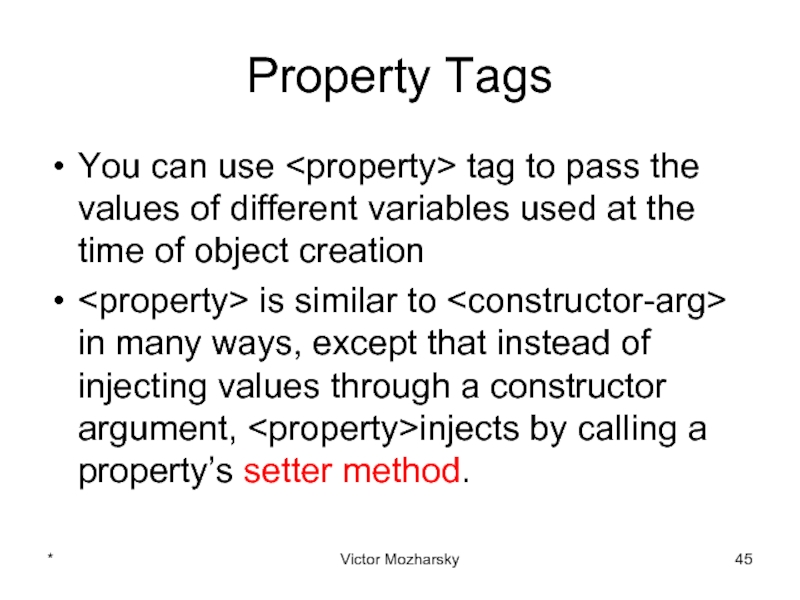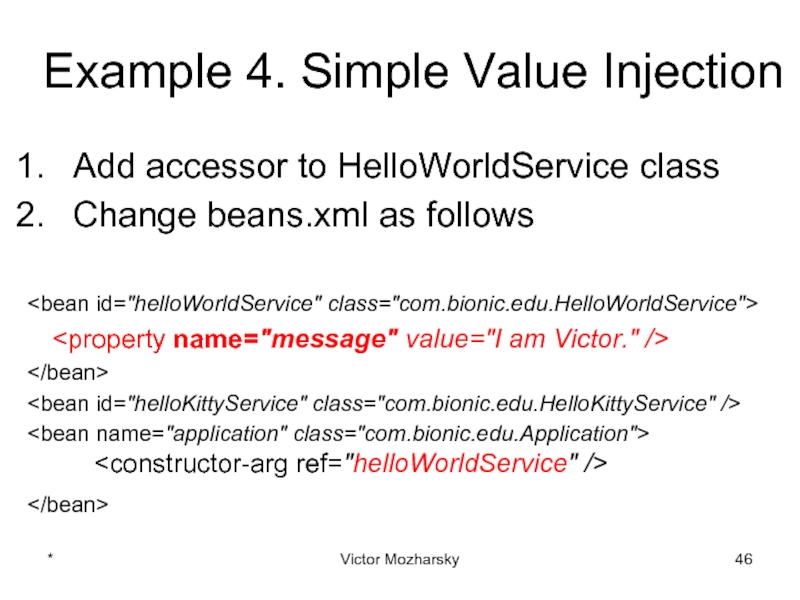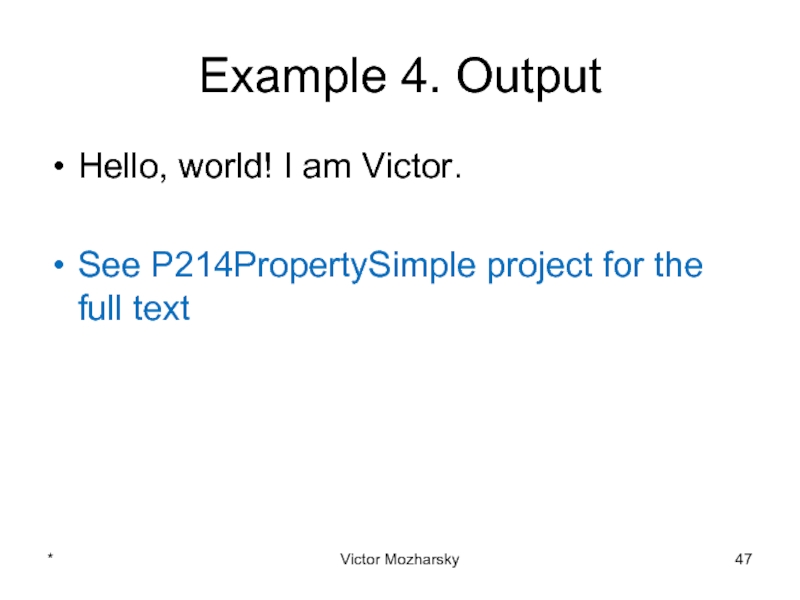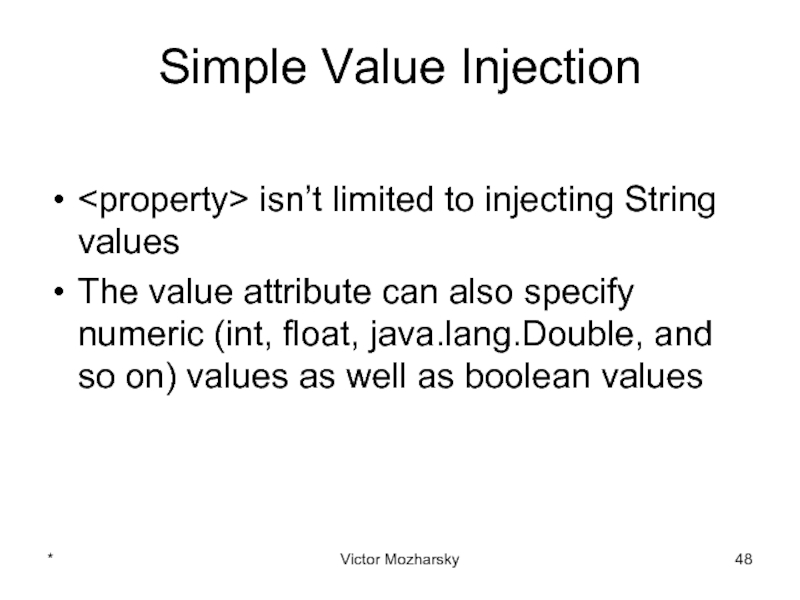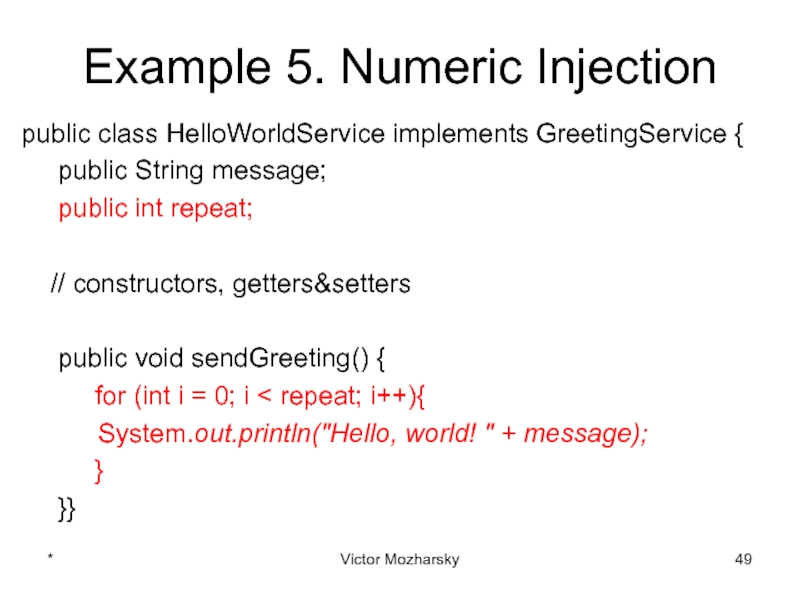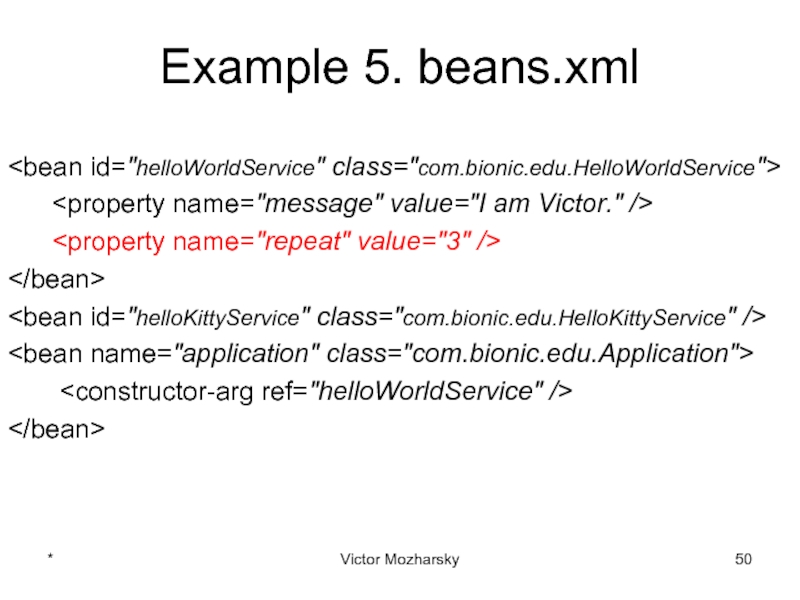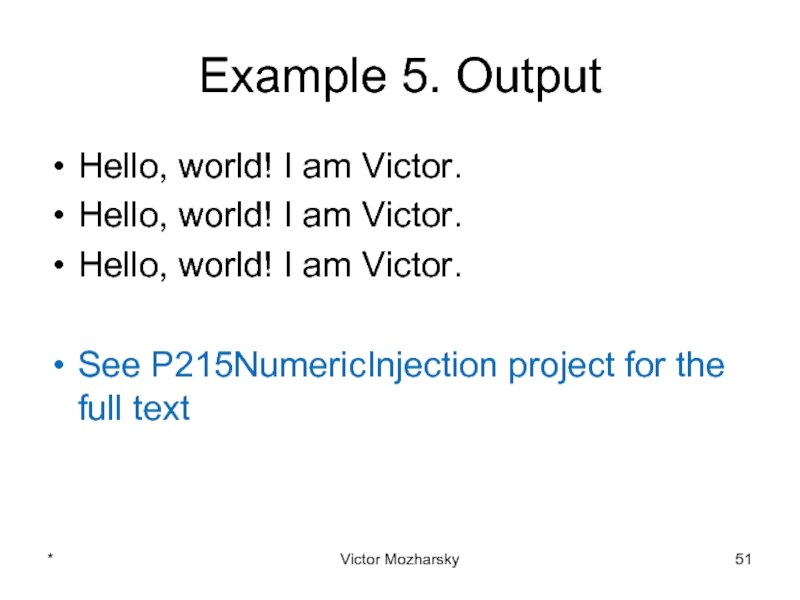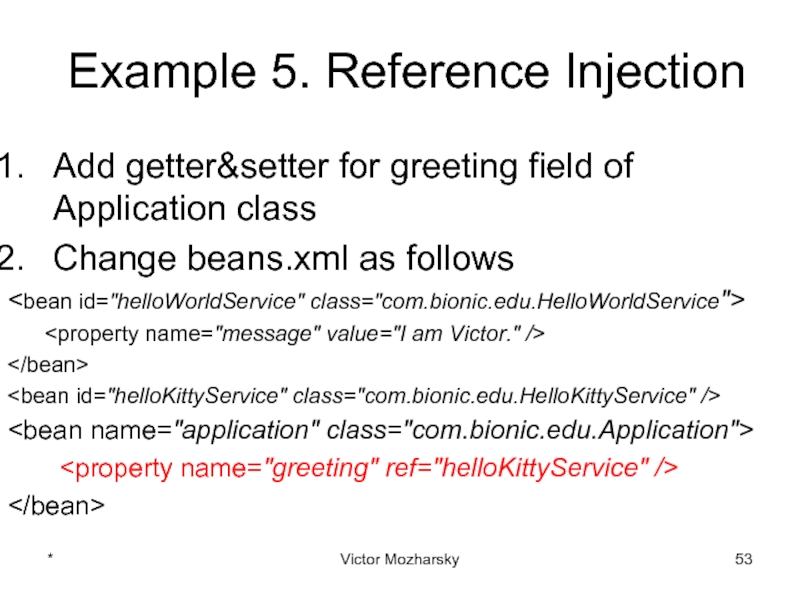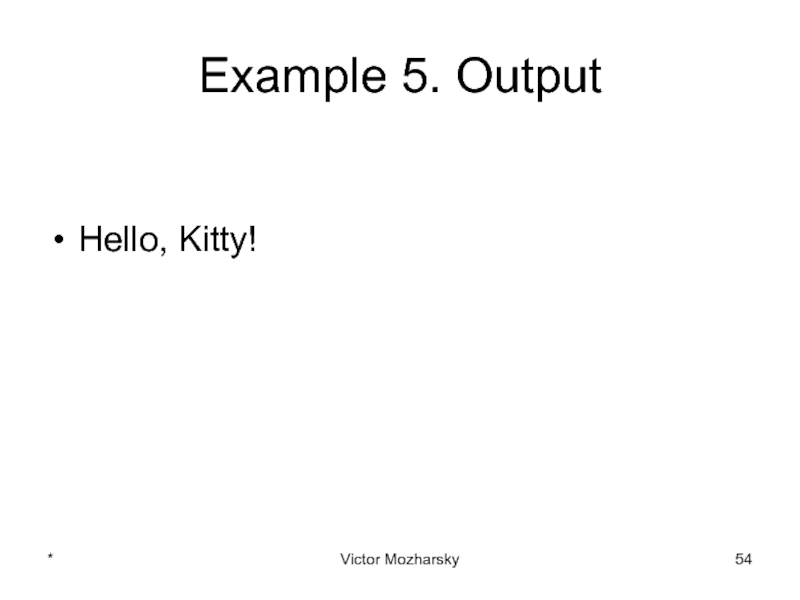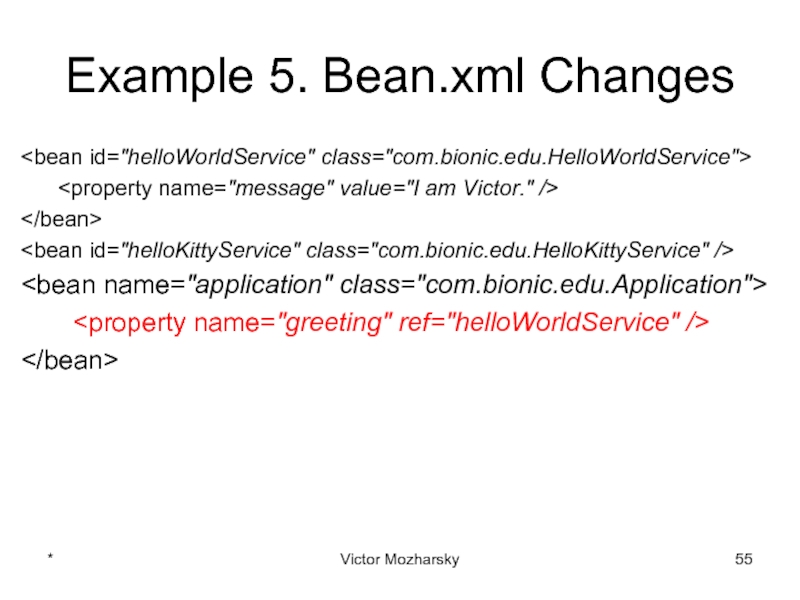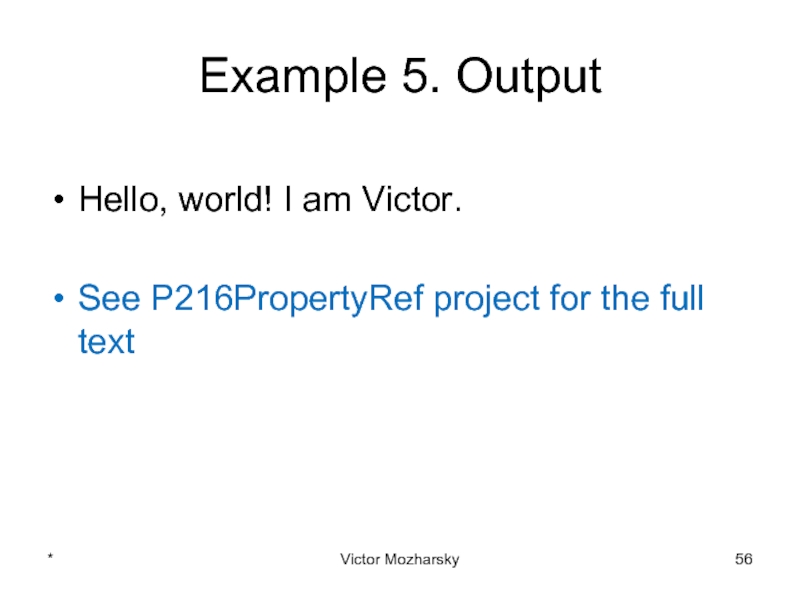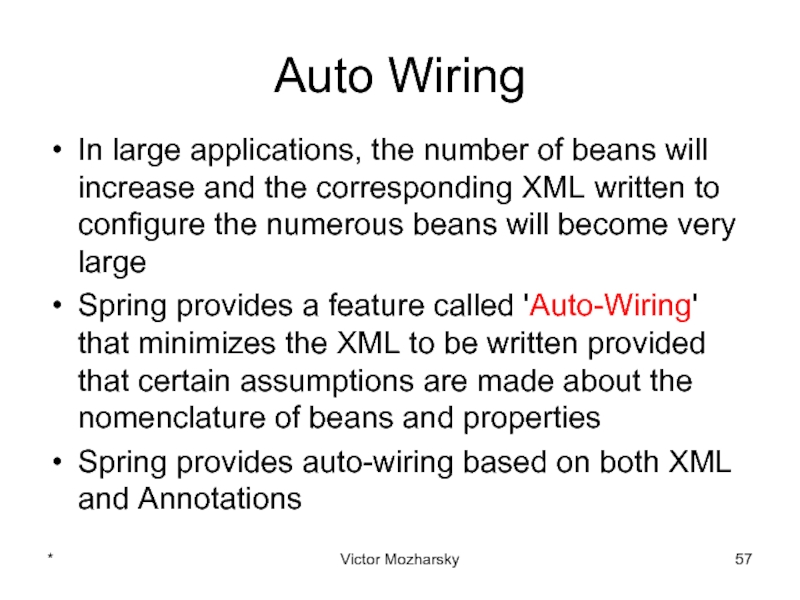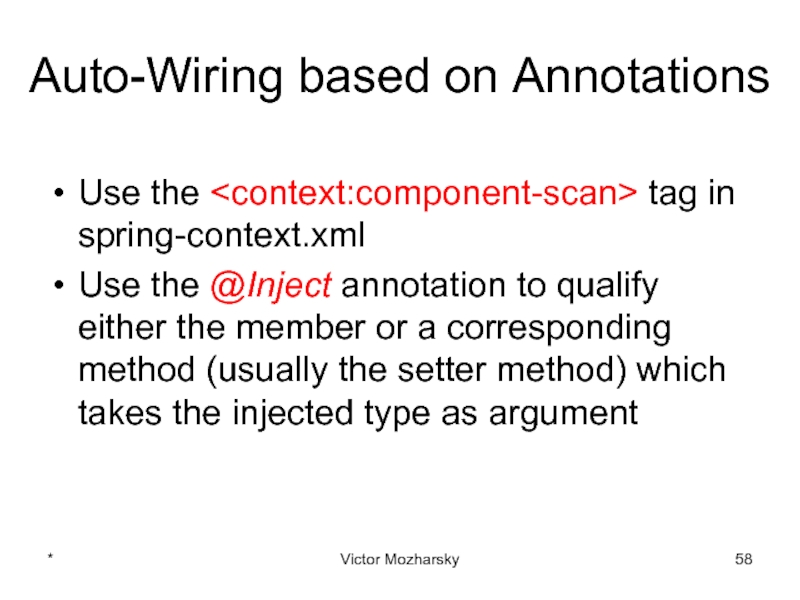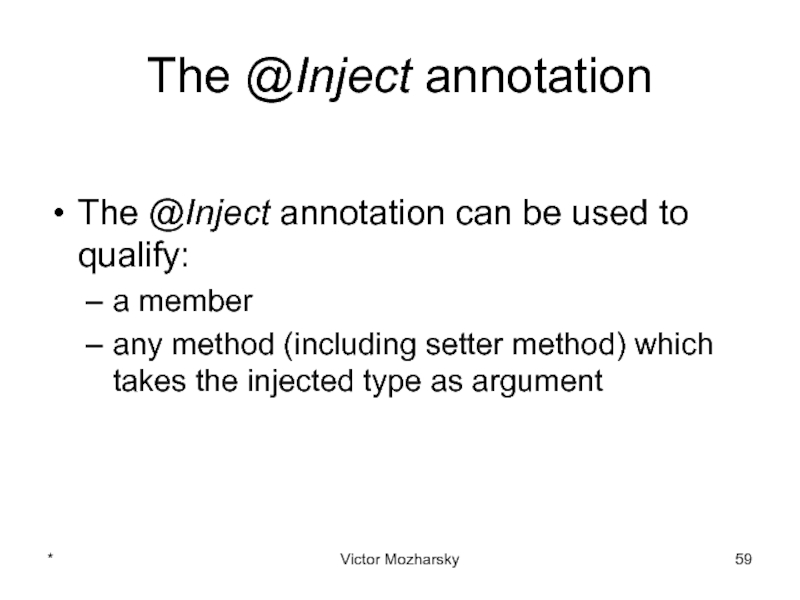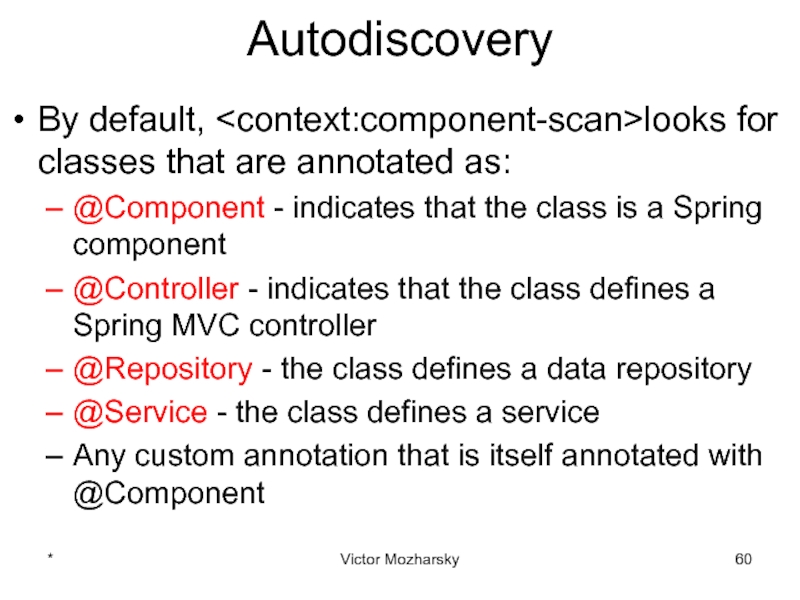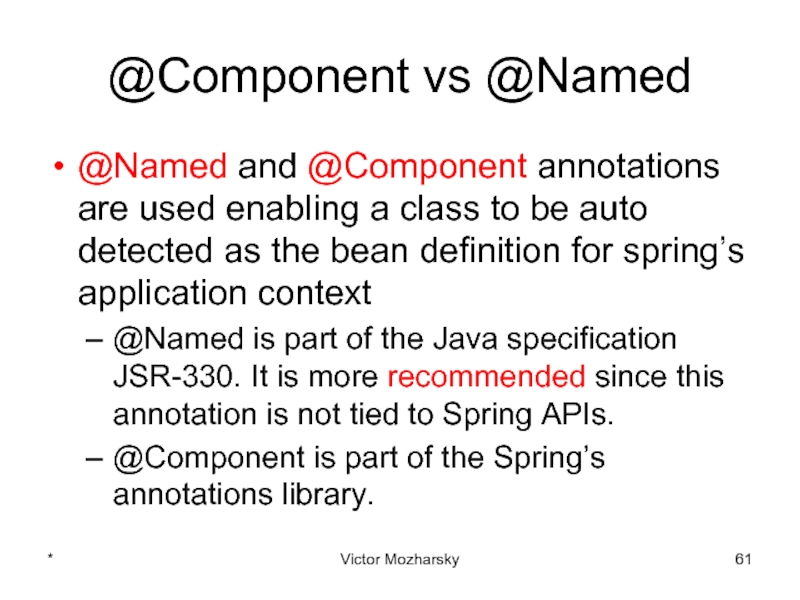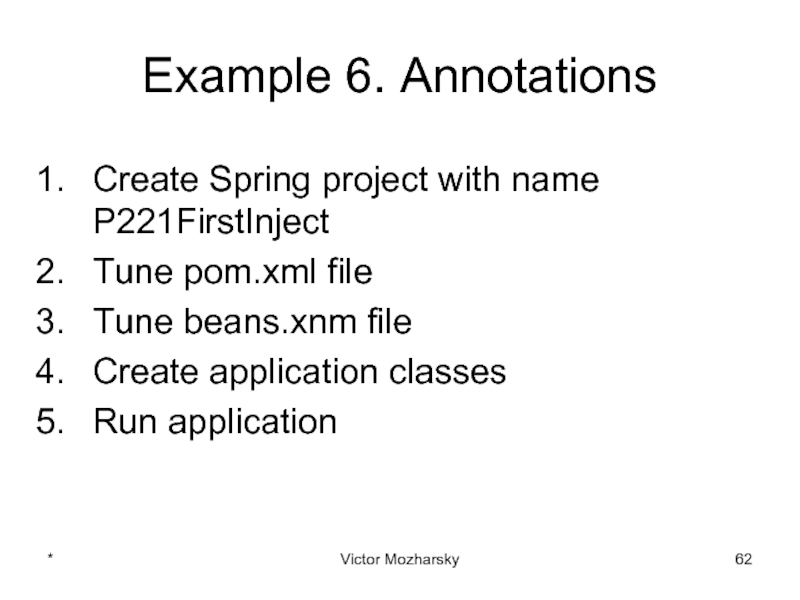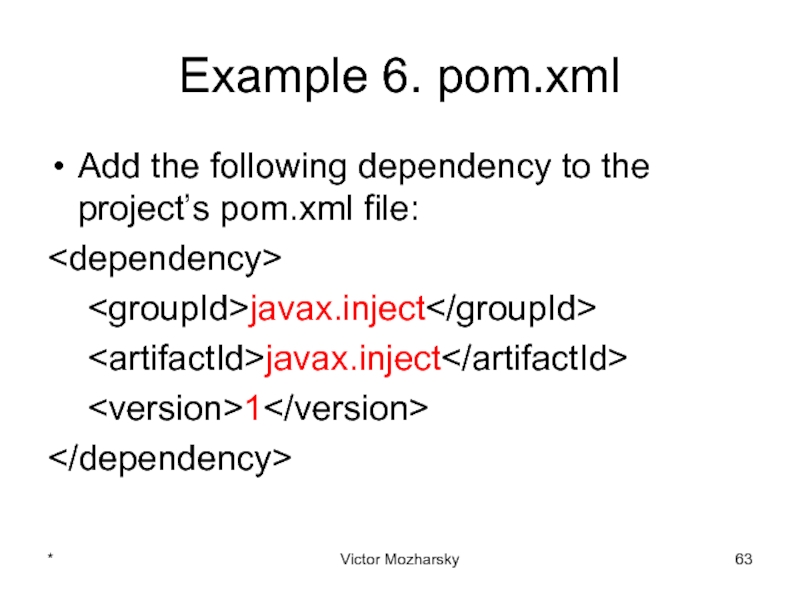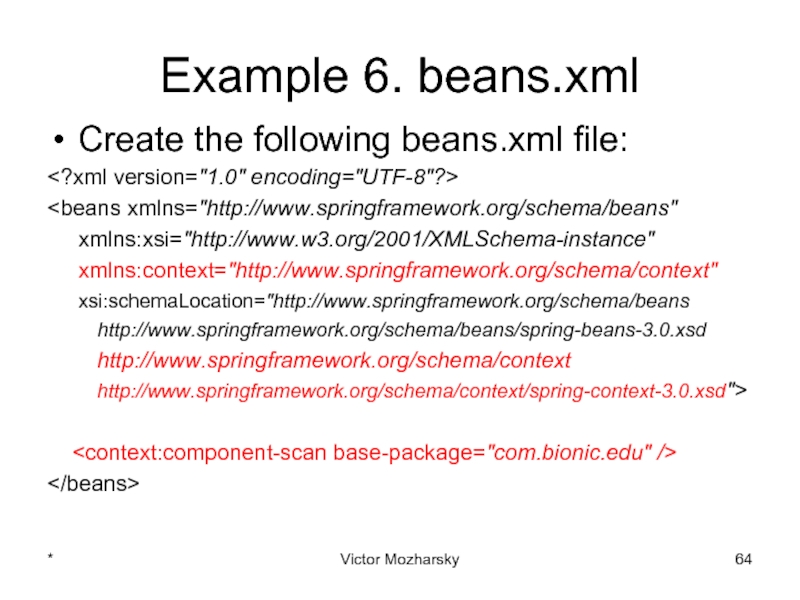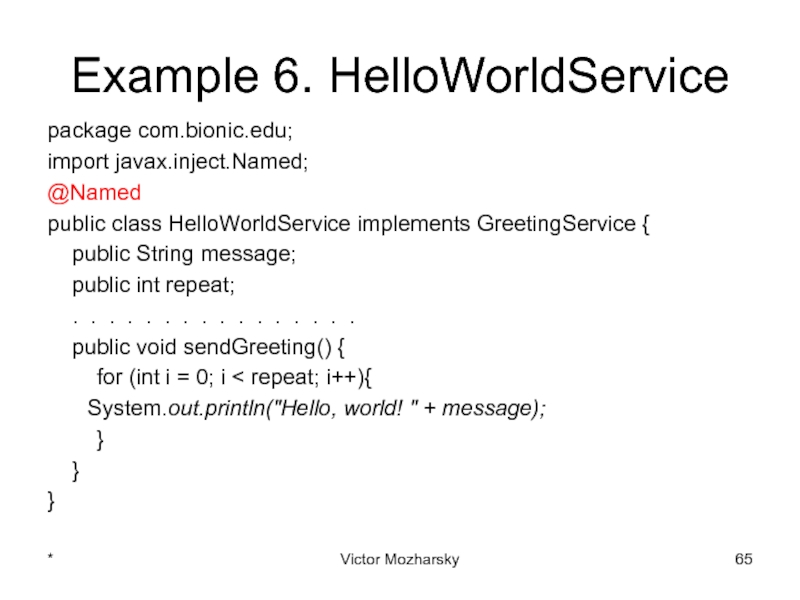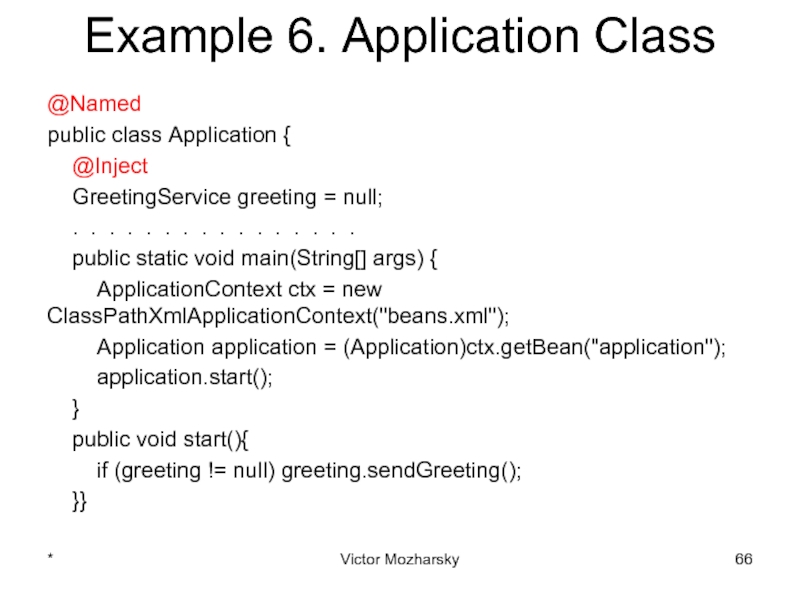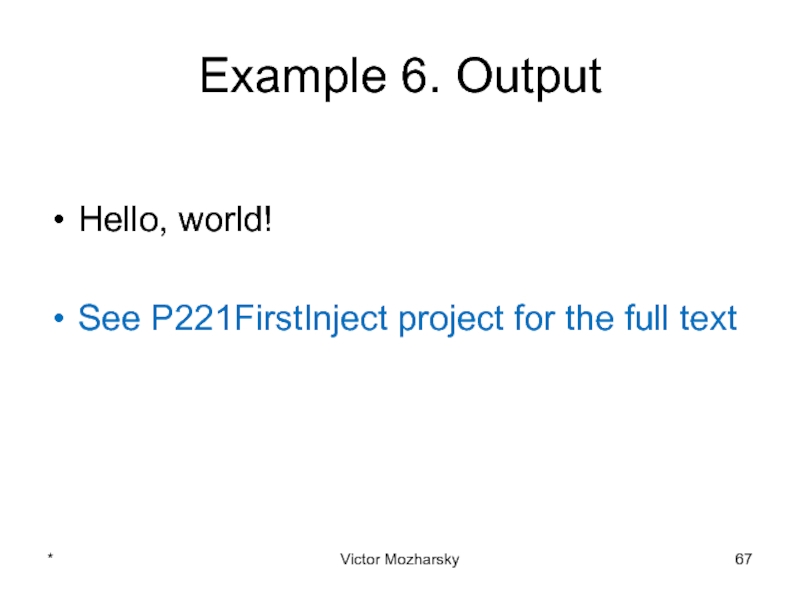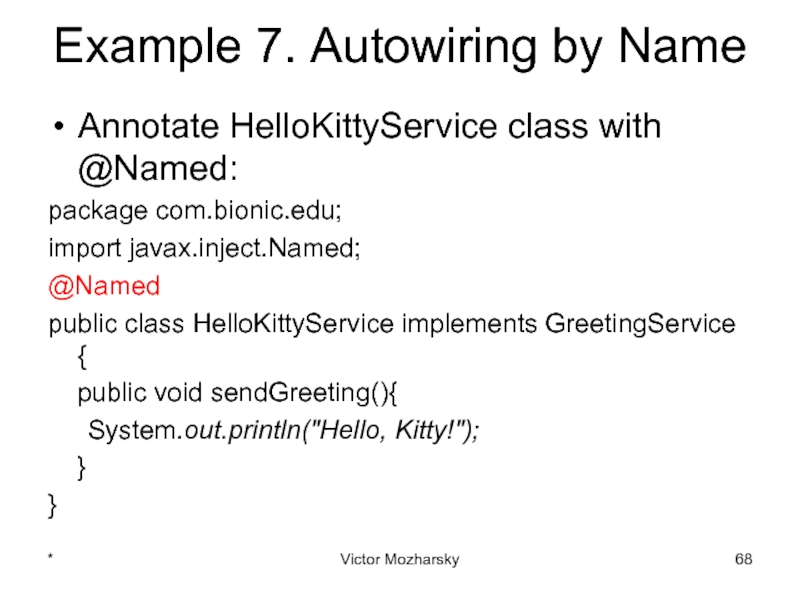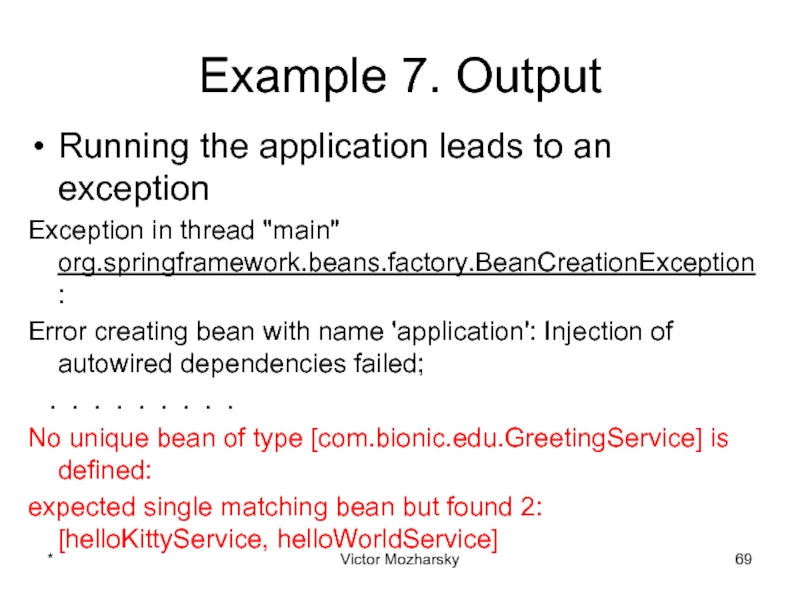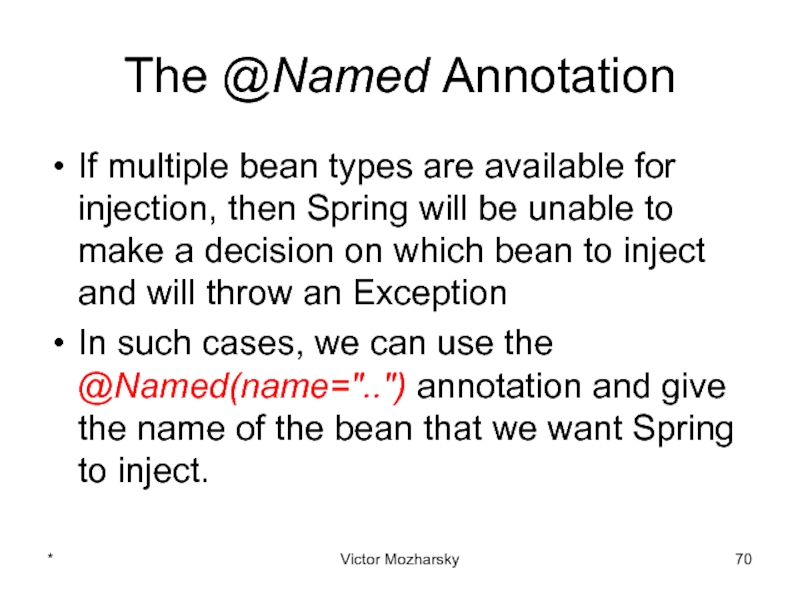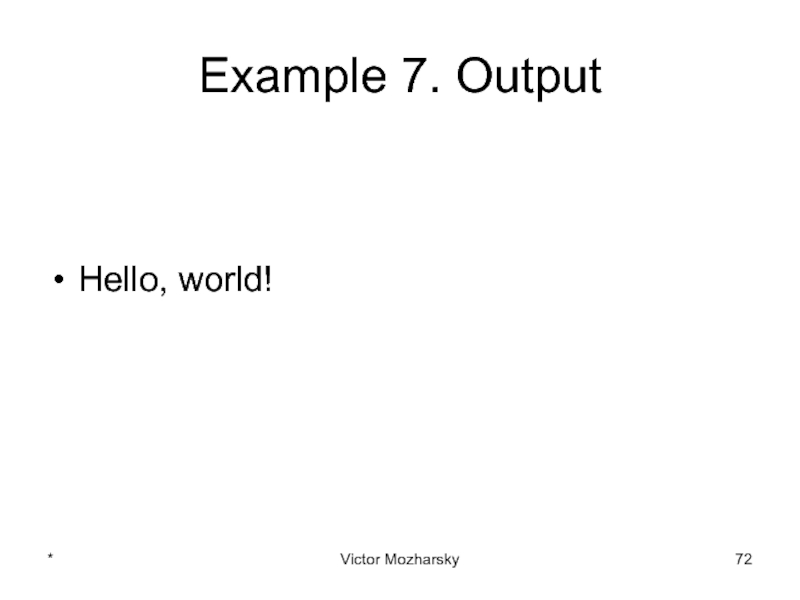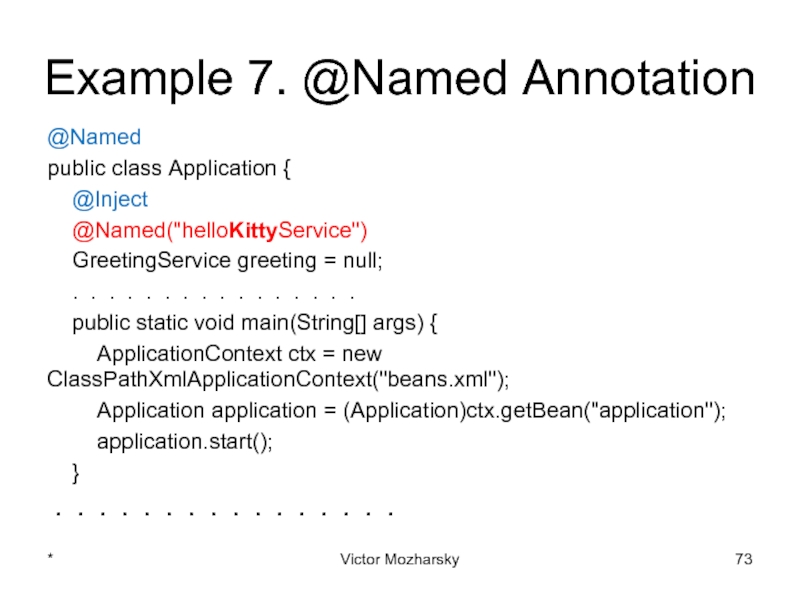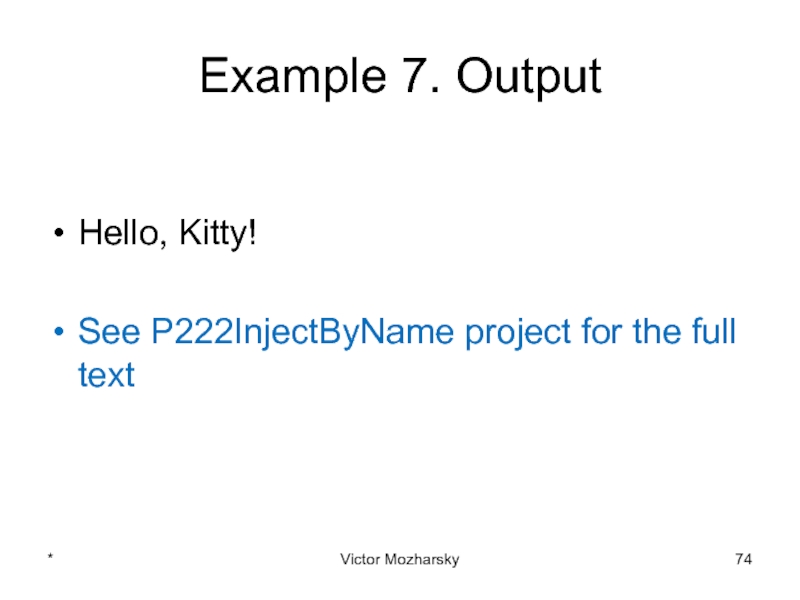- Главная
- Разное
- Дизайн
- Бизнес и предпринимательство
- Аналитика
- Образование
- Развлечения
- Красота и здоровье
- Финансы
- Государство
- Путешествия
- Спорт
- Недвижимость
- Армия
- Графика
- Культурология
- Еда и кулинария
- Лингвистика
- Английский язык
- Астрономия
- Алгебра
- Биология
- География
- Детские презентации
- Информатика
- История
- Литература
- Маркетинг
- Математика
- Медицина
- Менеджмент
- Музыка
- МХК
- Немецкий язык
- ОБЖ
- Обществознание
- Окружающий мир
- Педагогика
- Русский язык
- Технология
- Физика
- Философия
- Химия
- Шаблоны, картинки для презентаций
- Экология
- Экономика
- Юриспруденция
2. Java Spring Core 3. Spring IoC Container презентация
Содержание
- 1. 2. Java Spring Core 3. Spring IoC Container
- 2. The Spring Container The container will:
- 3. Dependency Injection The Spring container uses dependency
- 4. DI Implementation * Victor Mozharsky
- 5. Container’s Metadata The container gets its instructions
- 6. How Spring Works * Victor Mozharsky
- 7. Spring Bean Definition The objects that form
- 8. XML Metadata * Victor Mozharsky
- 9. Spring Bean Definition Each bean definition can
- 10. Bean Definition Attributes Class attribute is mandatory
- 11. Spring Tool Suite Installation Open Eclipse ->
- 12. Example 1. Hello World in Spring Create
- 13. Example 1. Create Spring Project File ->
- 14. Example 1. Create Spring Project Remove from
- 15. Example 1. Logging Dependencies *
- 16. Add Dependencies to the pom.xml File Open
- 17. Further pom.xml Tuning Select log4j (1.2.14) dependency
- 18. Maven clean&install actions Right click on the
- 19. Example 1. Hello World in Spring Create
- 20. Example 1. log4j2.xml in resources
- 21. Example 1. Hello World in Spring Create
- 22. E1. GreetingService Interface package com.bionic.edu; public
- 23. E1. HelloWorldService Class package com.bionic.edu; public
- 24. E1. HelloKittyService Class package com.bionic.edu; public
- 25. Example 1. Hello World in Spring Create
- 26. Bean Definition The element tells Spring to
- 27. Example 1. Bean Definition * Victor Mozharsky
- 28. Example 1. Configuration File Right click on
- 29. Example 1. Configuration File
- 30. Example 1. Hello World in Spring Create
- 31. Application Context You can load the
- 32. Example 1. Application Class package com.bionic.edu; import
- 33. Example 1. Hello World in Spring Create
- 34. Example 1. Run application. You will get
- 35. Injecting through Constructors A class can be
- 36. Example 2. HelloWorldService package com.bionic.edu; public
- 37. Example 2. Bean Definition * Victor Mozharsky
- 38. Example 2. Run application. You will get
- 39. Injecting Object References You should use ref
- 40. Example 3. Application Class public class Application
- 41. Example 3. Bean Definition
- 42. Example 3 Output Hello, world! I am Victor. * Victor Mozharsky
- 43. Example 3. Bean Definition
- 44. Example 3 Output Hello, Kitty! See
- 45. Property Tags You can use tag to
- 46. Example 4. Simple Value Injection Add accessor
- 47. Example 4. Output Hello, world! I am
- 48. Simple Value Injection isn’t limited to
- 49. Example 5. Numeric Injection public class
- 50. Example 5. beans.xml
- 51. Example 5. Output Hello, world! I am
- 52. Object Injection The real value of DI
- 53. Example 5. Reference Injection Add getter&setter for
- 54. Example 5. Output Hello, Kitty! * Victor Mozharsky
- 55. Example 5. Bean.xml Changes
- 56. Example 5. Output Hello, world! I am
- 57. Auto Wiring In large applications, the number
- 58. Auto-Wiring based on Annotations Use the tag
- 59. The @Inject annotation The @Inject annotation
- 60. Autodiscovery By default, looks for classes that
- 61. @Component vs @Named @Named and @Component annotations
- 62. Example 6. Annotations Create Spring project with
- 63. Example 6. pom.xml Add the following
- 64. Example 6. beans.xml Create the following beans.xml
- 65. Example 6. HelloWorldService package com.bionic.edu; import javax.inject.Named;
- 66. Example 6. Application Class @Named public class
- 67. Example 6. Output Hello, world!
- 68. Example 7. Autowiring by Name Annotate HelloKittyService
- 69. Example 7. Output Running the application leads
- 70. The @Named Annotation If multiple bean
- 71. Example 7. @Named Annotation @Named public class
- 72. Example 7. Output Hello, world! * Victor Mozharsky
- 73. Example 7. @Named Annotation @Named public class
- 74. Example 7. Output Hello, Kitty! See
Слайд 2The Spring Container
The container will:
create the objects
wire them together
manage their complete lifecycle from creation till destruction.
These objects are called Spring Beans
*
Victor Mozharsky
Слайд 3Dependency Injection
The Spring container uses dependency injection (DI) to manage the
In a complex Java application classes should be as independent as possible to increase the possibility to reuse these classes and to test them independently
Dependency Injection helps in connecting these classes together and same time keeping them independent.
*
Victor Mozharsky
Слайд 5Container’s Metadata
The container gets its instructions on what objects to instantiate,
by XML
Java annotations
Java code
*
Victor Mozharsky
Слайд 7Spring Bean Definition
The objects that form the backbone of your application
The bean definition contains the information called configuration metadata which is needed for the container to know:
How to create a bean
Bean's lifecycle details
Bean's dependencies
*
Victor Mozharsky
Слайд 8XML Metadata
http://www.springframework.org/schema/beans/spring-beans-3.0.xsd">
*
Victor Mozharsky
Слайд 9Spring Bean Definition
Each bean definition can contain a set of the
Class
Name
Scope
constructor-arg
Properties
autowiring mode
lazy-initialization mode
initialization method
destruction method
*
Victor Mozharsky
Слайд 10Bean Definition Attributes
Class attribute is mandatory and specify the bean class
Name attribute specifies the bean identifier uniquely. In XML-based configuration metadata, you use the id and/or name attributes to specify the bean identifier(s)
Properties is used to inject the dependencies
*
Victor Mozharsky
Слайд 11Spring Tool Suite Installation
Open Eclipse -> Help -> Eclipse Marketplace…
Find =
Restart Eclipse
*
Victor Mozharsky
Слайд 12Example 1. Hello World in Spring
Create Spring project
Tune project for logging
Create
Create Spring metadata
Create application context
Run application
*
Victor Mozharsky
Слайд 13Example 1. Create Spring Project
File -> New -> Other.. -> Spring
Project name = P211BeanDefinition, Templates = Simple Spring Utility Project -> Next
Package = com.bionic.edu -> Finish
*
Victor Mozharsky
Слайд 14Example 1. Create Spring Project
Remove from com.bionic.edu package (src/main/java) template files
Remove from com.bionic.edu package (src/test/java) template files ExampleConfigurationTests.java and ExampleServiceTests.java
*
Victor Mozharsky
Слайд 16Add Dependencies to the pom.xml File
Open pom.xml -> Dependencies tab ->
Press Add button -> GroupId = org.slf4j, ArifactId = slf4j-api, Vesion = 1.7.5 -> Ok
Press Add button -> GroupId = org.apache. logging.log4j, ArtifactId = log4j-api, Version = 2.0.2 -> Ok
And so on… Then -> Save
*
Слайд 17Further pom.xml Tuning
Select log4j (1.2.14) dependency and click Remove button
Go to
Change Spring version to 4.1.1.RELEASE in
Save pom.xml file
*
Victor Mozharsky
Слайд 18Maven clean&install actions
Right click on the project’s name -> Maven ->
Right click on the project’s name -> Run As… -> Maven clean
Right click on the project’s name -> Run As… -> Maven install
*
Слайд 19Example 1. Hello World in Spring
Create Spring project
Tune project for logging
Create
Create Spring metadata
Create application context
Run application
*
Victor Mozharsky
Слайд 21Example 1. Hello World in Spring
Create Spring project
Tune project for logging
Create
Create Spring metadata
Create application context
Run application
*
Victor Mozharsky
Слайд 22E1. GreetingService Interface
package com.bionic.edu;
public interface GreetingService {
void sendGreeting();
}
*
Victor Mozharsky
Слайд 23E1. HelloWorldService Class
package com.bionic.edu;
public class HelloWorldService implements
GreetingService {
System.out.println("Hello, world!");
}
}
*
Victor Mozharsky
Слайд 24E1. HelloKittyService Class
package com.bionic.edu;
public class HelloKittyService implements GreetingService {
System.out.println("Hello, Kitty!");
}
}
*
Victor Mozharsky
Слайд 25Example 1. Hello World in Spring
Create Spring project
Tune project for logging
Create
Create Spring metadata
Create application context
Run application
*
Victor Mozharsky
Слайд 26Bean Definition
The element tells Spring to create an object for
The id attribute gives the bean a name by which it’ll be referred to in the Spring container.
When the Spring container loads its beans, it’ll instantiate the bean using the default constructor.
*
Victor Mozharsky
Слайд 28Example 1. Configuration File
Right click on src/main/resources -> New -> File
Fill
Create configuration file context (see next slide) -> Save
*
Victor Mozharsky
Слайд 29Example 1. Configuration File
http://www.springframework.org/schema/beans/spring-beans-3.0.xsd">
*
Victor Mozharsky
Слайд 30Example 1. Hello World in Spring
Create Spring project
Tune project for logging
Create
Create Spring metadata
Create application context
Run application
*
Victor Mozharsky
Слайд 31Application Context
You can load the Spring application context using the
ApplicationContext ctx = new ClassPathXmlApplicationContext("beans.xml");
GreetingService service = (GreetingService)ctx.getBean("helloWorldService");
service.sendGreeting();
*
Victor Mozharsky
Слайд 32Example 1. Application Class
package com.bionic.edu;
import org.springframework.context.ApplicationContext;
import org.springframework.context.support.ClassPathXmlApplicationContext;
public class Application {
ApplicationContext ctx = new ClassPathXmlApplicationContext("beans.xml");
GreetingService service =
(GreetingService)ctx.getBean("helloWorldService");
service.sendGreeting();
}
}
*
Victor Mozharsky
Слайд 33Example 1. Hello World in Spring
Create Spring project
Tune project for logging
Create
Create Spring metadata
Create application context
Run application
*
Victor Mozharsky
Слайд 34Example 1.
Run application. You will get
Hello, world!
See P211BeanDefinition project for the
*
Victor Mozharsky
Слайд 35Injecting through Constructors
A class can be constructed in two different ways:
Using
Using a constructor that takes an argument(s)
If no
A
*
Victor Mozharsky
Слайд 36Example 2. HelloWorldService
package com.bionic.edu;
public class HelloWorldService implements GreetingService {
public HelloWorldService(){ message = ""; }
public HelloWorldService(String message){
this.message = message;
}
public void sendGreeting() {
System.out.println("Hello, world! " + message);
}
}
*
Victor Mozharsky
Слайд 38Example 2.
Run application. You will get
Hello, world! I am Victor.
See P212ConstructorInjection
*
Victor Mozharsky
Слайд 39Injecting Object References
You should use ref attribute in a for
*
Victor Mozharsky
Слайд 40Example 3. Application Class
public class Application {
GreetingService greeting
public Application(){}
public Application(GreetingService greeting){ this.greeting = greeting; }
public static void main(String[] args) {
ApplicationContext ctx = new
ClassPathXmlApplicationContext("beans.xml");
Application application = (Application)ctx.getBean("application");
application.start();
}
public void start(){
if (greeting != null) greeting.sendGreeting();
} }
*
Victor Mozharsky
Слайд 43Example 3. Bean Definition
*
Victor Mozharsky
Слайд 44Example 3 Output
Hello, Kitty!
See P213ConstructorInjection project for the full text
*
Victor Mozharsky
Слайд 45Property Tags
You can use tag to pass the values of
*
Victor Mozharsky
Слайд 46Example 4. Simple Value Injection
Add accessor to HelloWorldService class
Change beans.xml as
*
Victor Mozharsky
Слайд 47Example 4. Output
Hello, world! I am Victor.
See P214PropertySimple project for the
*
Victor Mozharsky
Слайд 48Simple Value Injection
isn’t limited to injecting String values
The value attribute
*
Victor Mozharsky
Слайд 49Example 5. Numeric Injection
public class HelloWorldService implements GreetingService {
public int repeat;
// constructors, getters&setters
public void sendGreeting() {
for (int i = 0; i < repeat; i++){
System.out.println("Hello, world! " + message);
}
}}
*
Victor Mozharsky
Слайд 51Example 5. Output
Hello, world! I am Victor.
Hello, world! I am Victor.
Hello,
See P215NumericInjection project for the full text
*
Victor Mozharsky
Слайд 52Object Injection
The real value of DI is found in wiring an
Use ref attribute of
*
Victor Mozharsky
Слайд 53Example 5. Reference Injection
Add getter&setter for greeting field of Application class
Change
*
Victor Mozharsky
Слайд 56Example 5. Output
Hello, world! I am Victor.
See P216PropertyRef project for the
*
Victor Mozharsky
Слайд 57Auto Wiring
In large applications, the number of beans will increase and
Spring provides a feature called 'Auto-Wiring' that minimizes the XML to be written provided that certain assumptions are made about the nomenclature of beans and properties
Spring provides auto-wiring based on both XML and Annotations
*
Victor Mozharsky
Слайд 58Auto-Wiring based on Annotations
Use the tag in spring-context.xml
Use the
*
Victor Mozharsky
Слайд 59The @Inject annotation
The @Inject annotation can be used to qualify:
a member
any method (including setter method) which takes the injected type as argument
*
Victor Mozharsky
Слайд 60Autodiscovery
By default, looks for classes that are annotated as:
@Component - indicates
@Controller - indicates that the class defines a Spring MVC controller
@Repository - the class defines a data repository
@Service - the class defines a service
Any custom annotation that is itself annotated with @Component
*
Victor Mozharsky
Слайд 61@Component vs @Named
@Named and @Component annotations are used enabling a class
@Named is part of the Java specification JSR-330. It is more recommended since this annotation is not tied to Spring APIs.
@Component is part of the Spring’s annotations library.
*
Victor Mozharsky
Слайд 62Example 6. Annotations
Create Spring project with name P221FirstInject
Tune pom.xml file
Tune beans.xnm
Create application classes
Run application
*
Victor Mozharsky
Слайд 63Example 6. pom.xml
Add the following dependency to the project’s pom.xml
*
Victor Mozharsky
Слайд 64Example 6. beans.xml
Create the following beans.xml file:
xmlns:context="http://www.springframework.org/schema/context"
xsi:schemaLocation="http://www.springframework.org/schema/beans
http://www.springframework.org/schema/beans/spring-beans-3.0.xsd
http://www.springframework.org/schema/context
http://www.springframework.org/schema/context/spring-context-3.0.xsd">
*
Victor Mozharsky
Слайд 65Example 6. HelloWorldService
package com.bionic.edu;
import javax.inject.Named;
@Named
public class HelloWorldService implements GreetingService {
public int repeat;
. . . . . . . . . . . . . . . .
public void sendGreeting() {
for (int i = 0; i < repeat; i++){
System.out.println("Hello, world! " + message);
}
}
}
*
Victor Mozharsky
Слайд 66Example 6. Application Class
@Named
public class Application {
@Inject
GreetingService
. . . . . . . . . . . . . . . .
public static void main(String[] args) {
ApplicationContext ctx = new ClassPathXmlApplicationContext("beans.xml");
Application application = (Application)ctx.getBean("application");
application.start();
}
public void start(){
if (greeting != null) greeting.sendGreeting();
}}
*
Victor Mozharsky
Слайд 67Example 6. Output
Hello, world!
See P221FirstInject project for the full text
*
Victor
Слайд 68Example 7. Autowiring by Name
Annotate HelloKittyService class with @Named:
package com.bionic.edu;
import javax.inject.Named;
@Named
public
public void sendGreeting(){
System.out.println("Hello, Kitty!");
}
}
*
Victor Mozharsky
Слайд 69Example 7. Output
Running the application leads to an exception
Exception in thread
Error creating bean with name 'application': Injection of autowired dependencies failed;
. . . . . . . . .
No unique bean of type [com.bionic.edu.GreetingService] is defined:
expected single matching bean but found 2: [helloKittyService, helloWorldService]
*
Victor Mozharsky
Слайд 70The @Named Annotation
If multiple bean types are available for injection,
In such cases, we can use the @Named(name="..") annotation and give the name of the bean that we want Spring to inject.
*
Victor Mozharsky
Слайд 71Example 7. @Named Annotation
@Named
public class Application {
@Inject
@Named("helloWorldService")
. . . . . . . . . . . . . . . .
public static void main(String[] args) {
ApplicationContext ctx = new ClassPathXmlApplicationContext("beans.xml");
Application application = (Application)ctx.getBean("application");
application.start();
}
. . . . . . . . . . . . . . . .
*
Victor Mozharsky
Слайд 73Example 7. @Named Annotation
@Named
public class Application {
@Inject
@Named("helloKittyService")
. . . . . . . . . . . . . . . .
public static void main(String[] args) {
ApplicationContext ctx = new ClassPathXmlApplicationContext("beans.xml");
Application application = (Application)ctx.getBean("application");
application.start();
}
. . . . . . . . . . . . . . . .
*
Victor Mozharsky
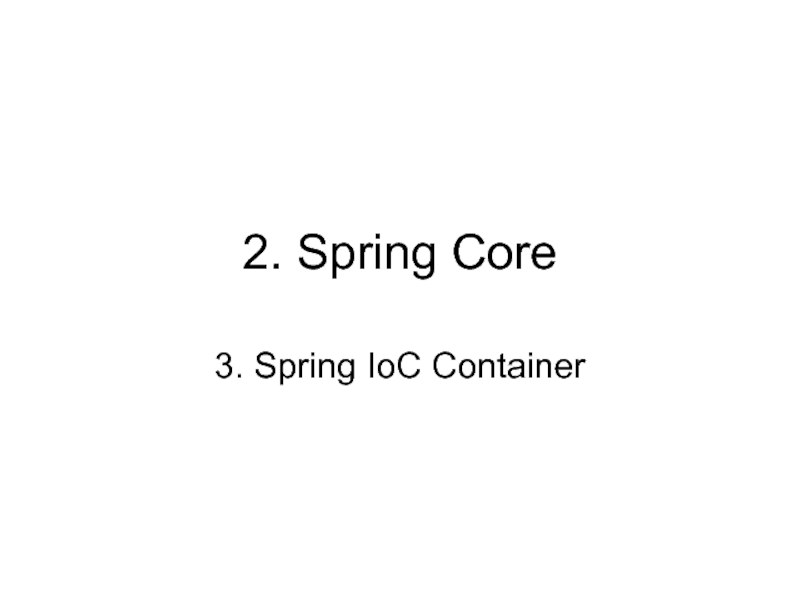
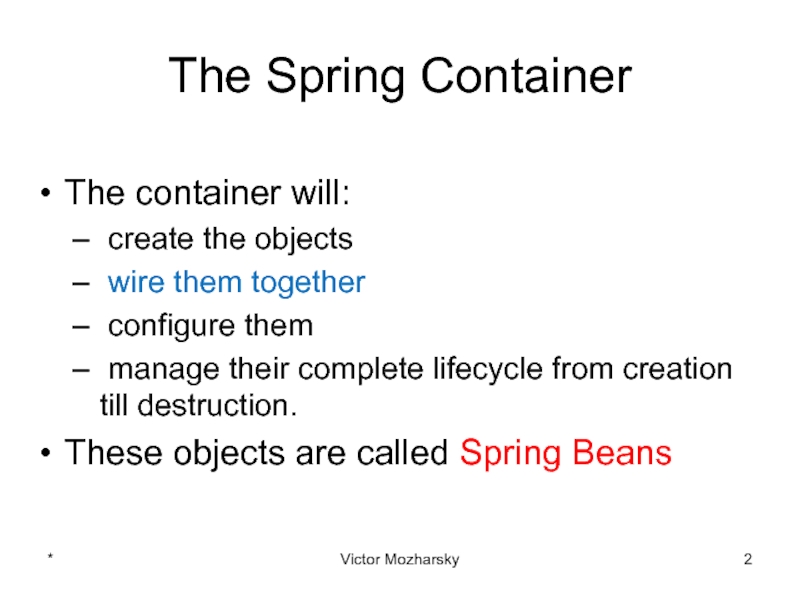
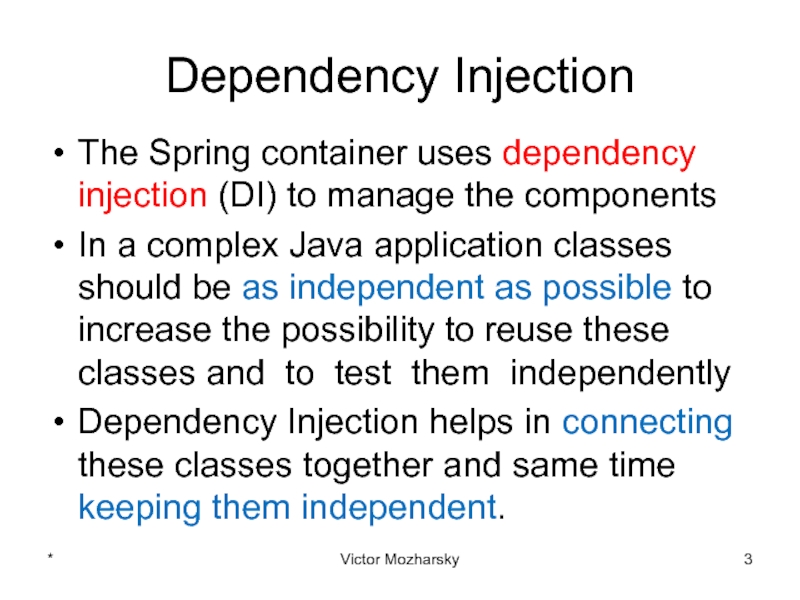
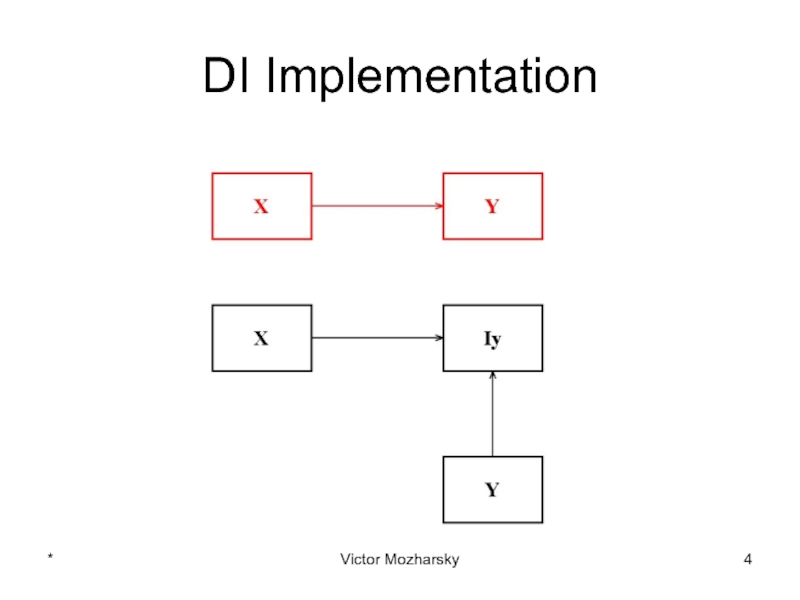
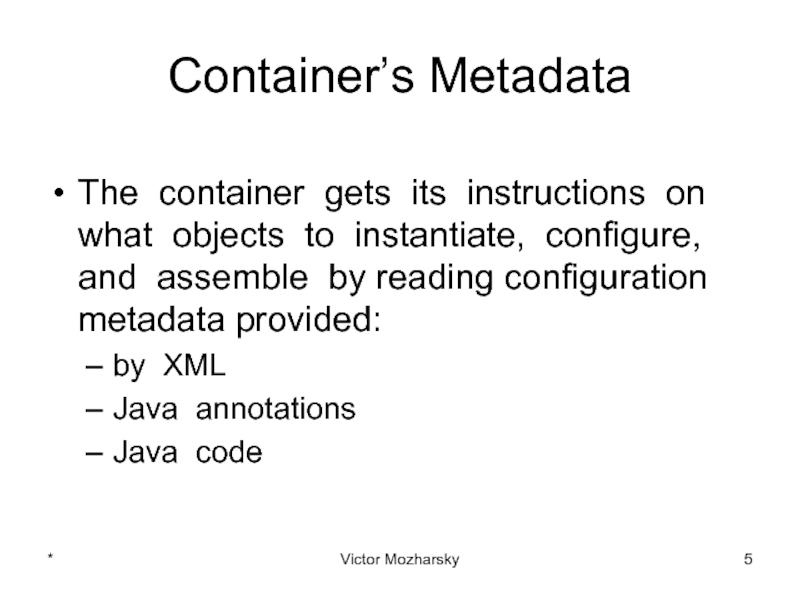
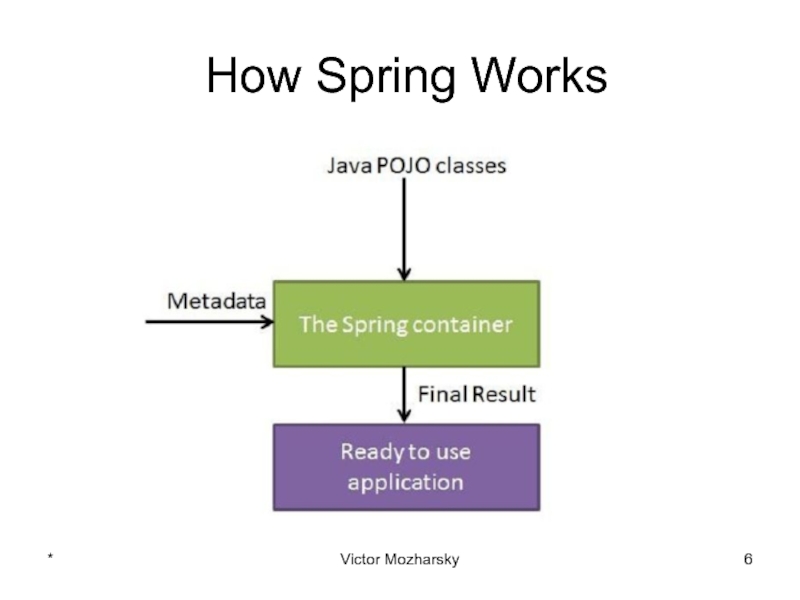
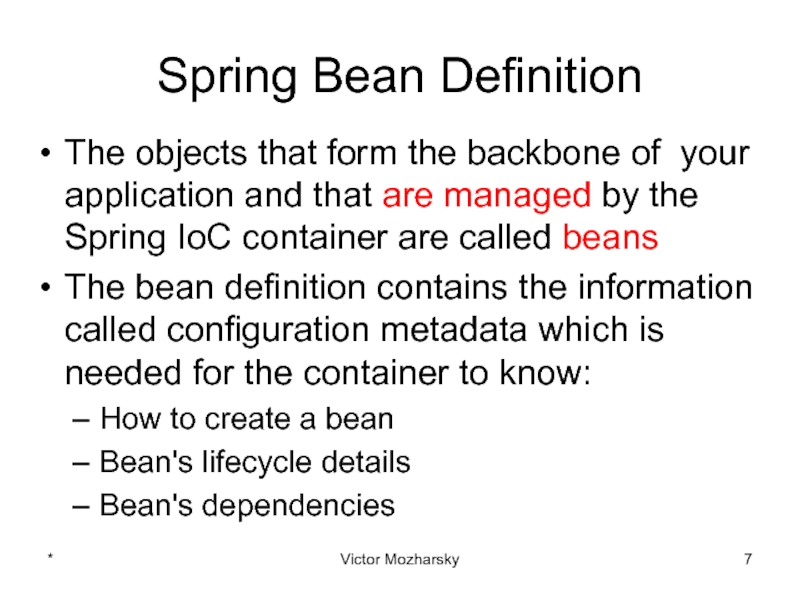
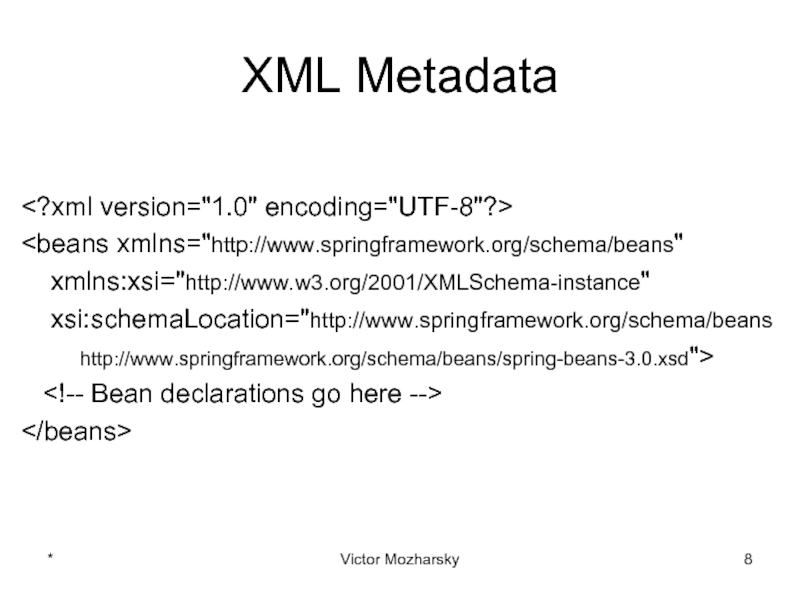
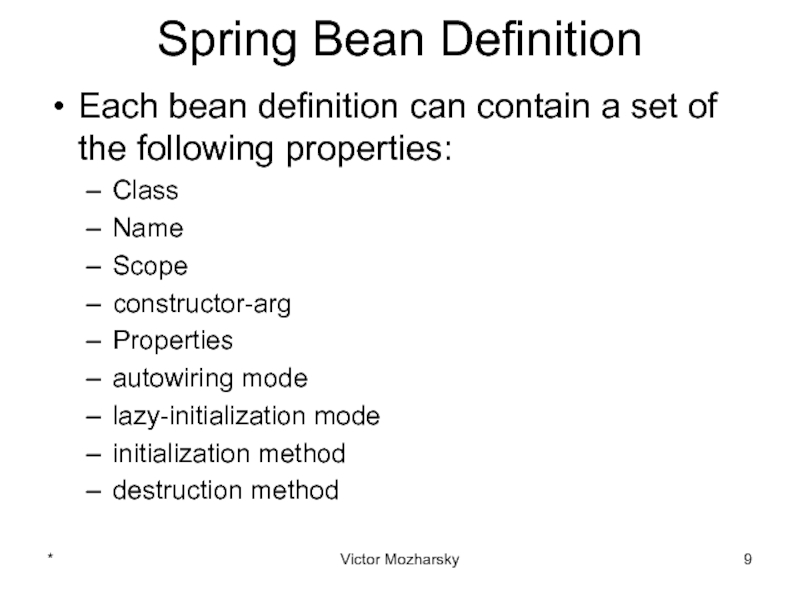
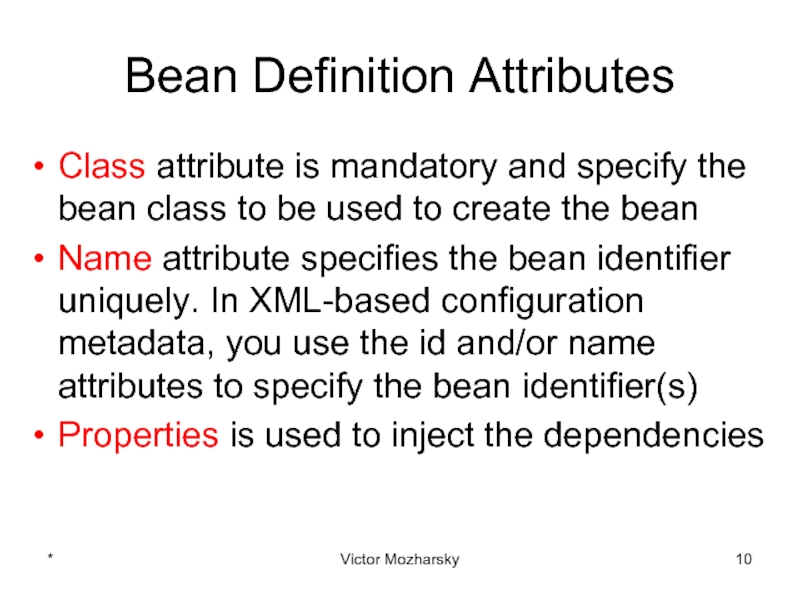

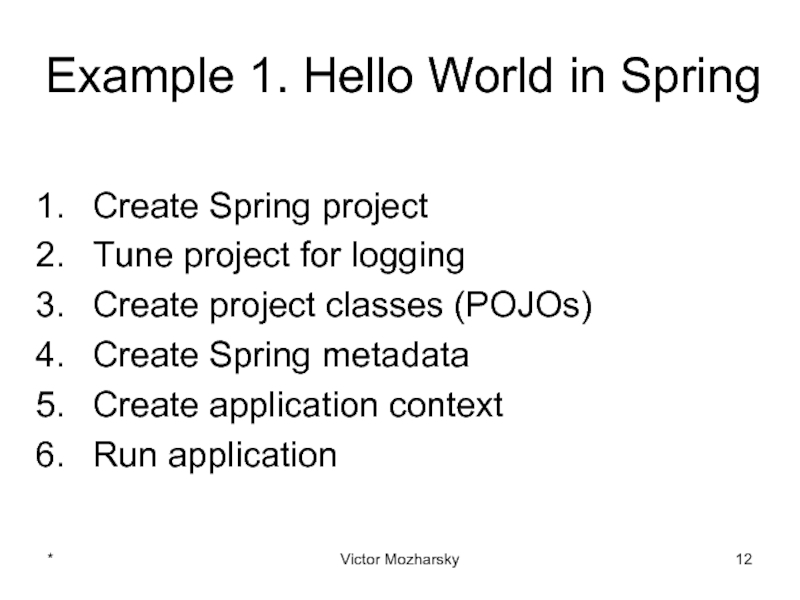
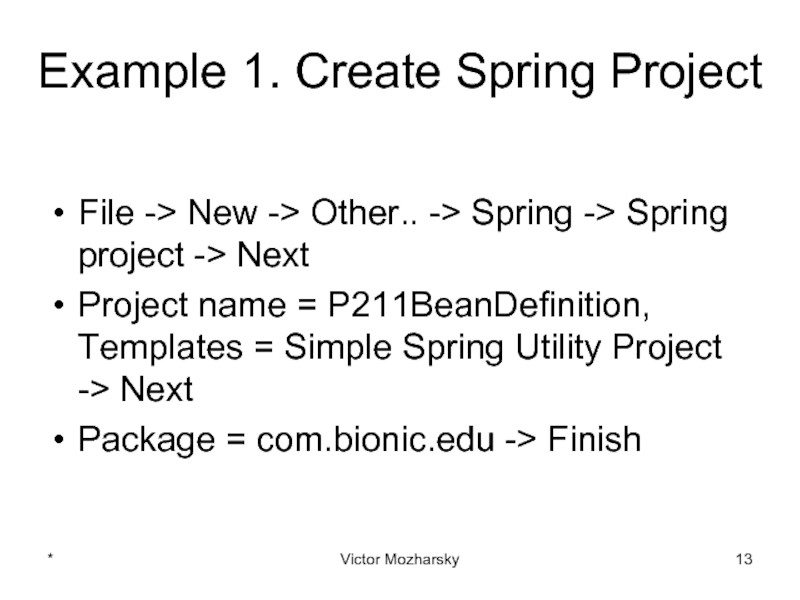
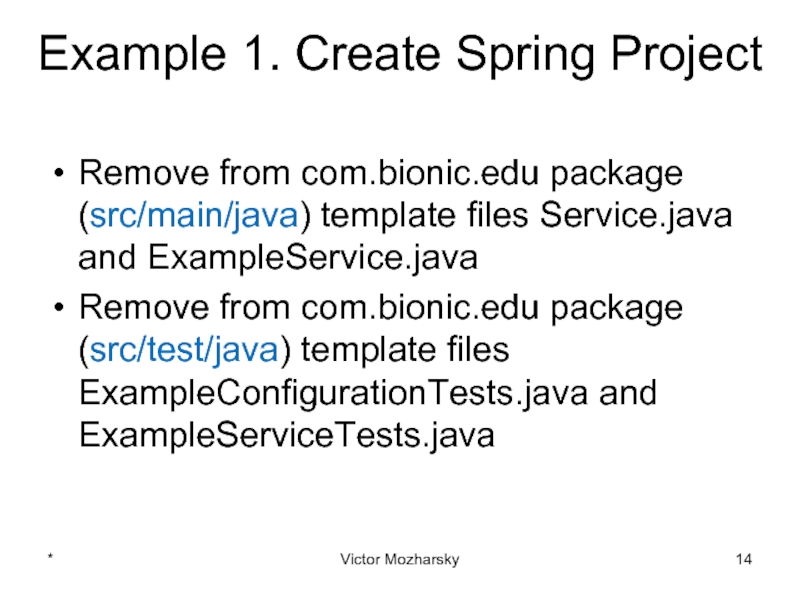
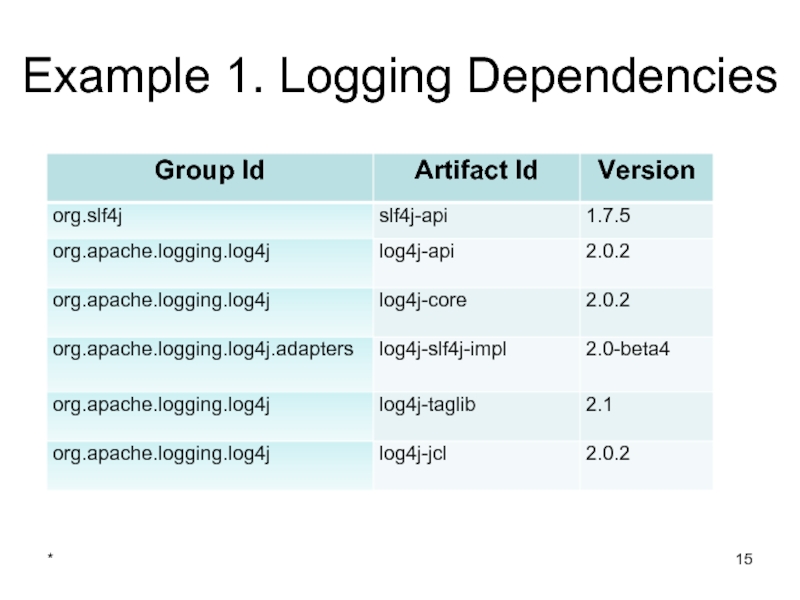
![Add Dependencies to the pom.xml FileOpen pom.xml -> Dependencies tab -> select junit: 3.8.1[test] ->](/img/tmb/2/125298/4e43f3b724e144f337c50e293d765c5c-800x.jpg)
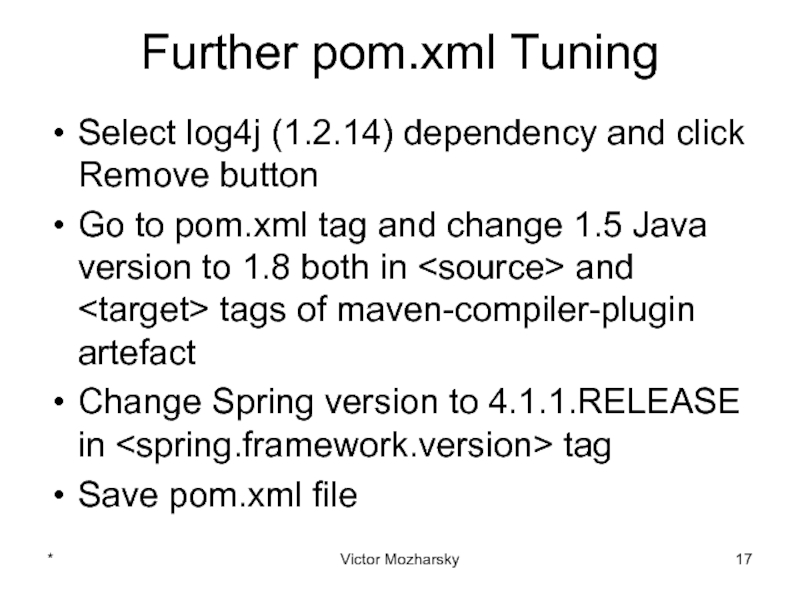
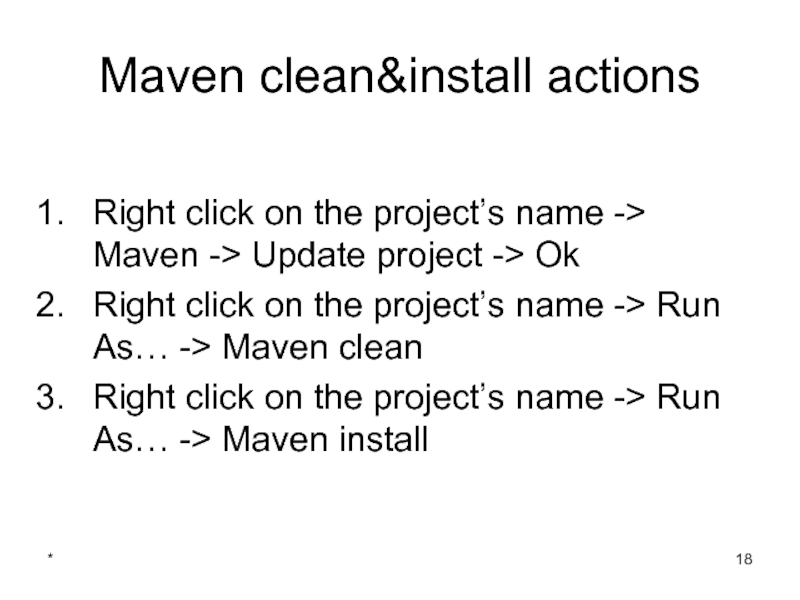
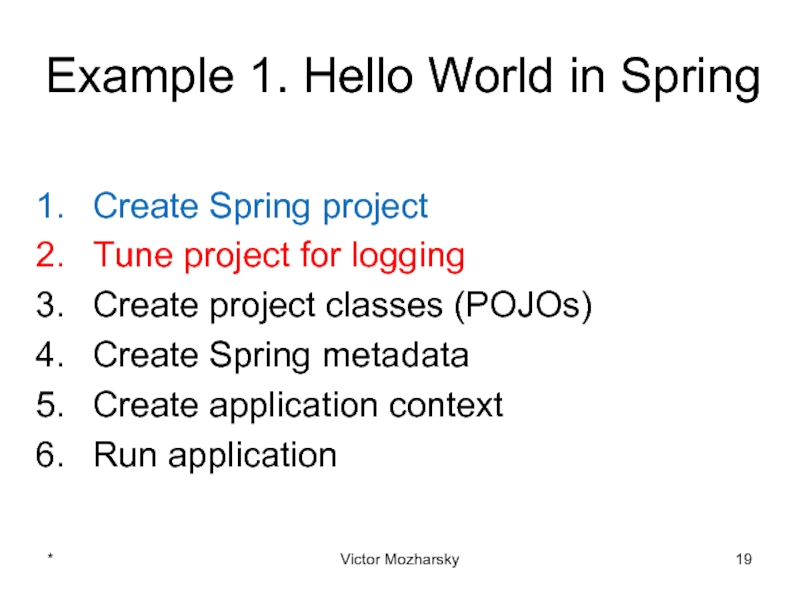
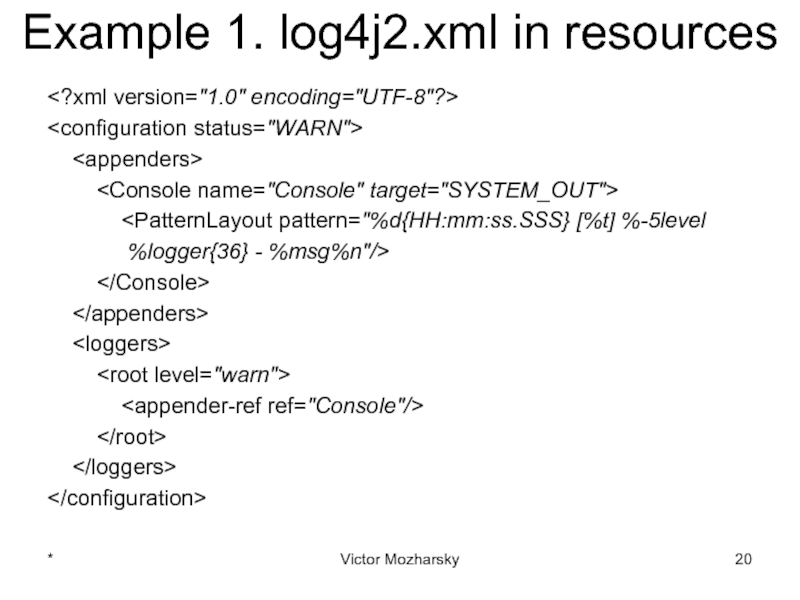
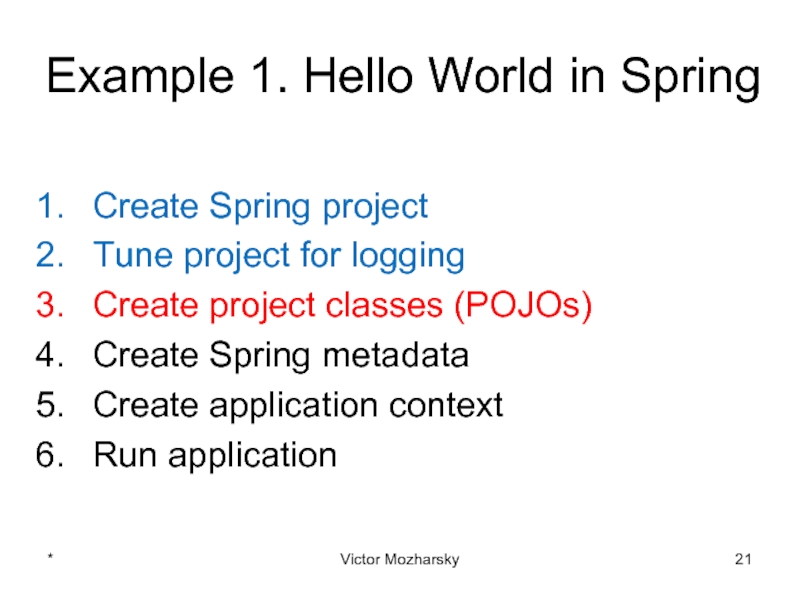
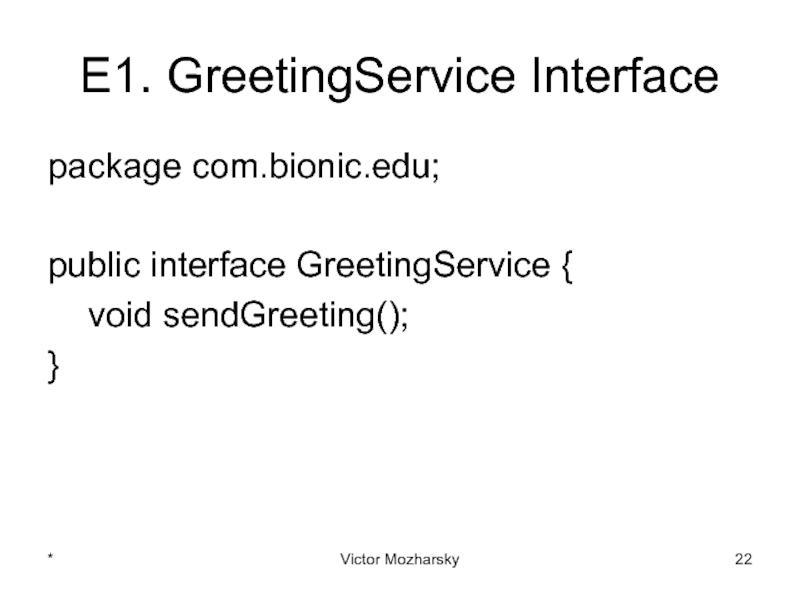
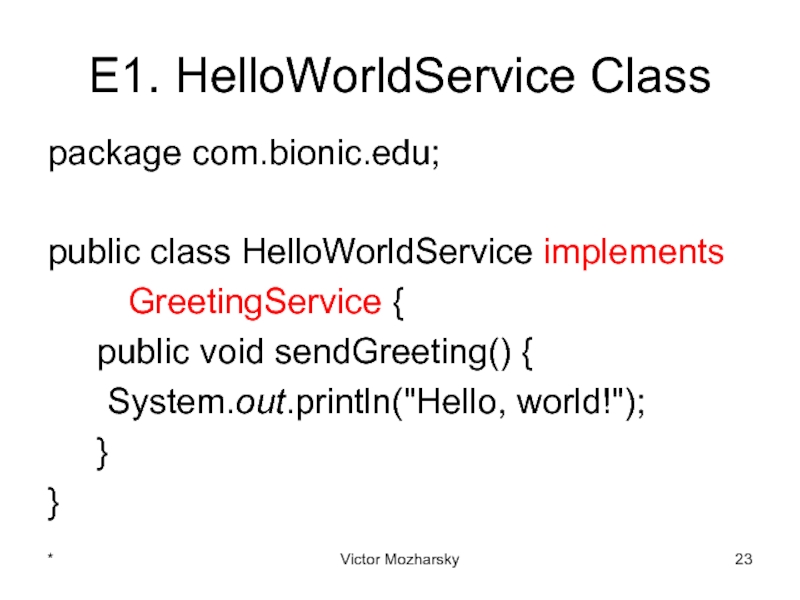
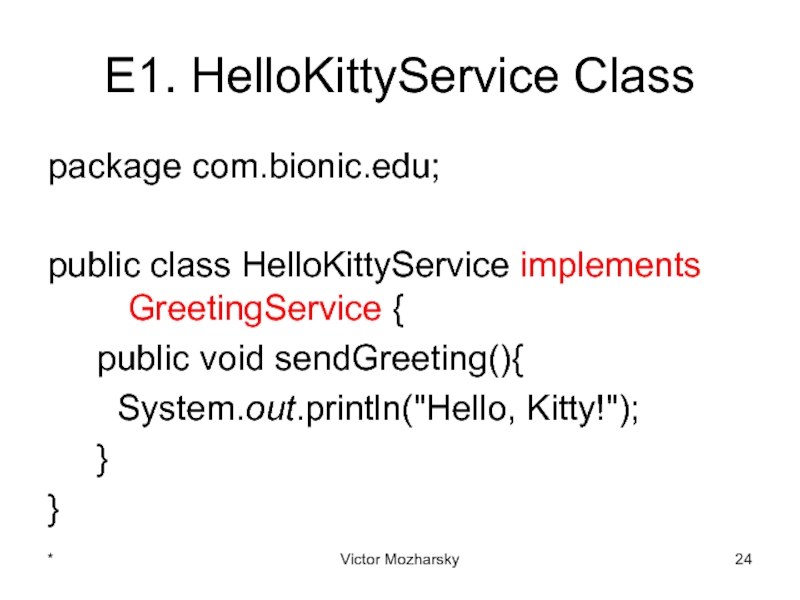
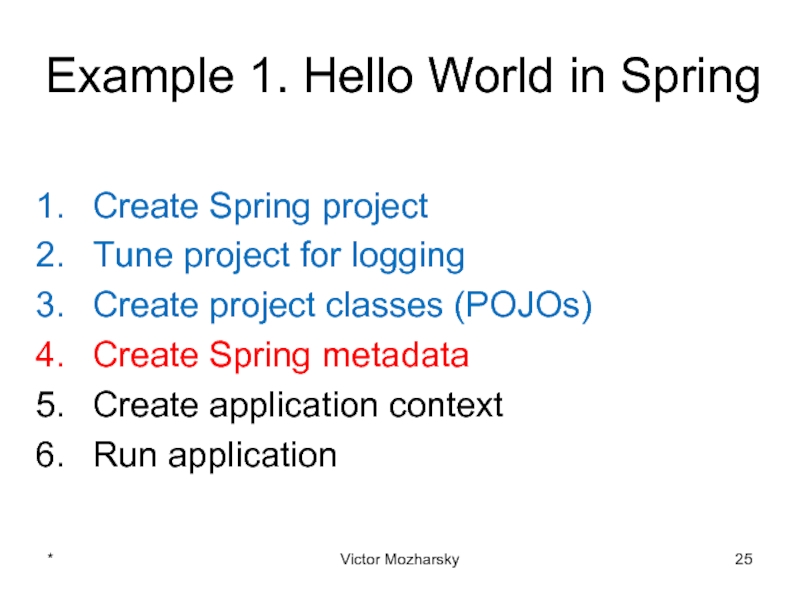
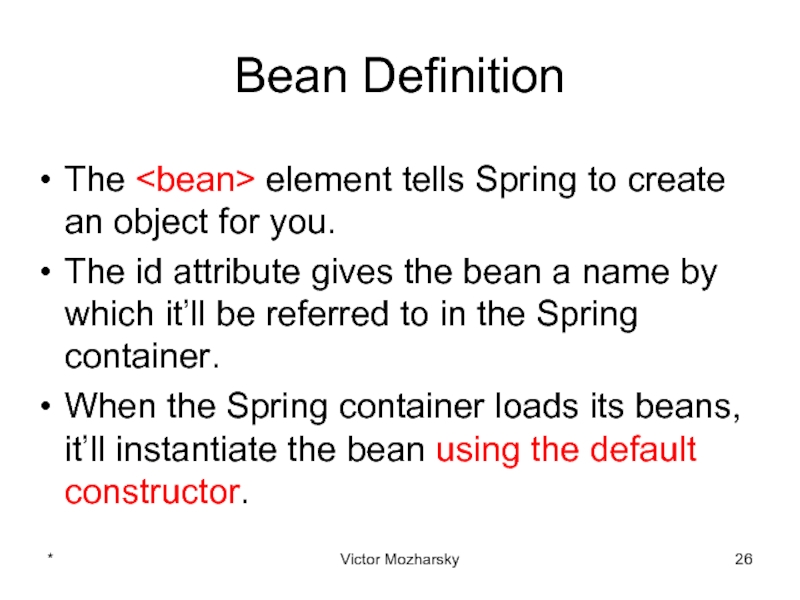
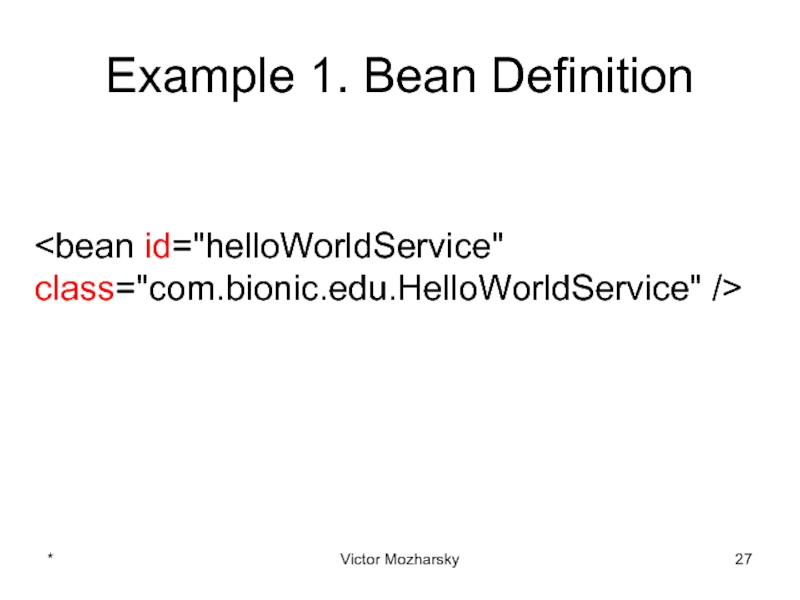
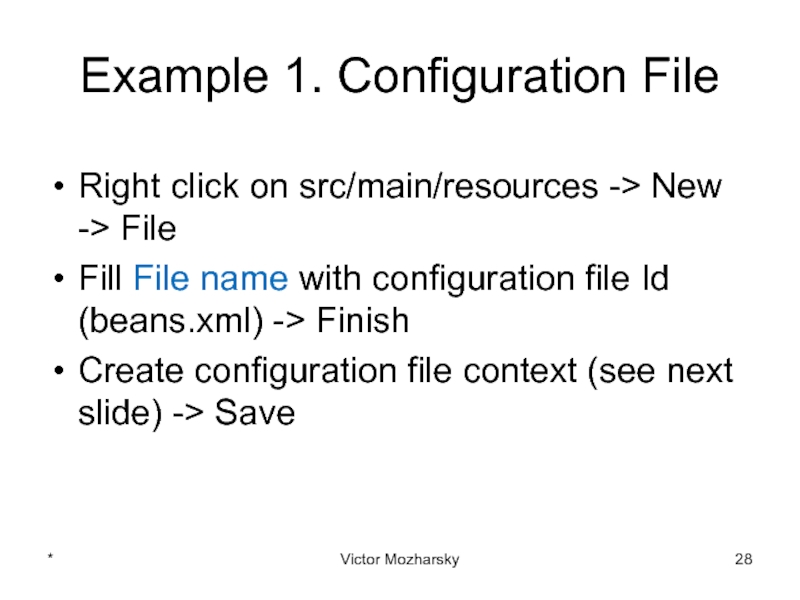
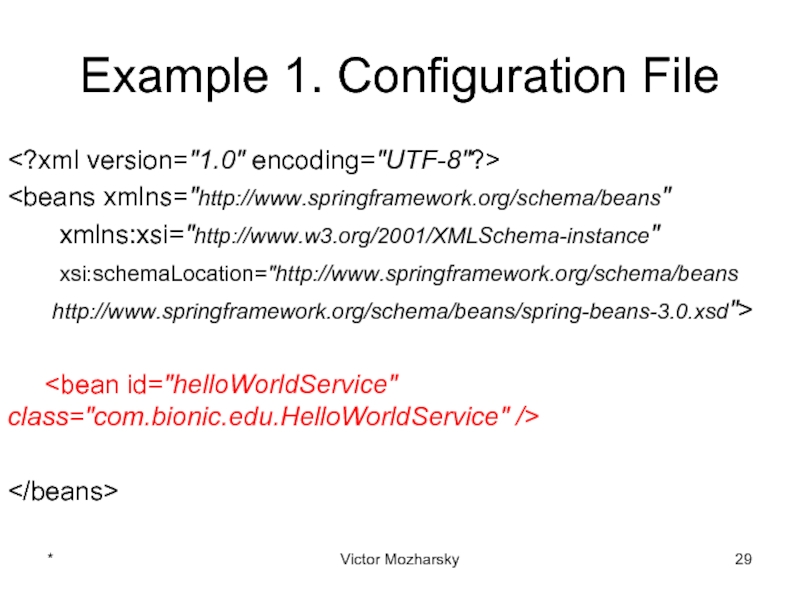
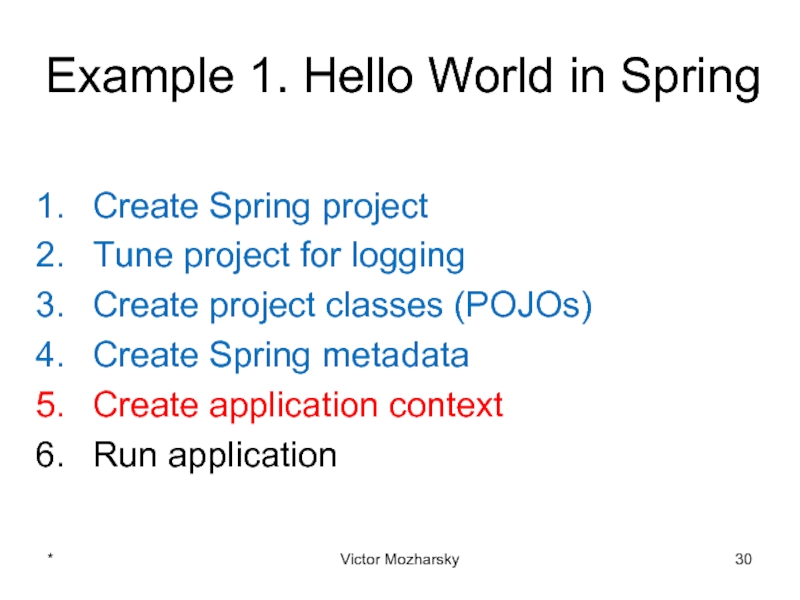
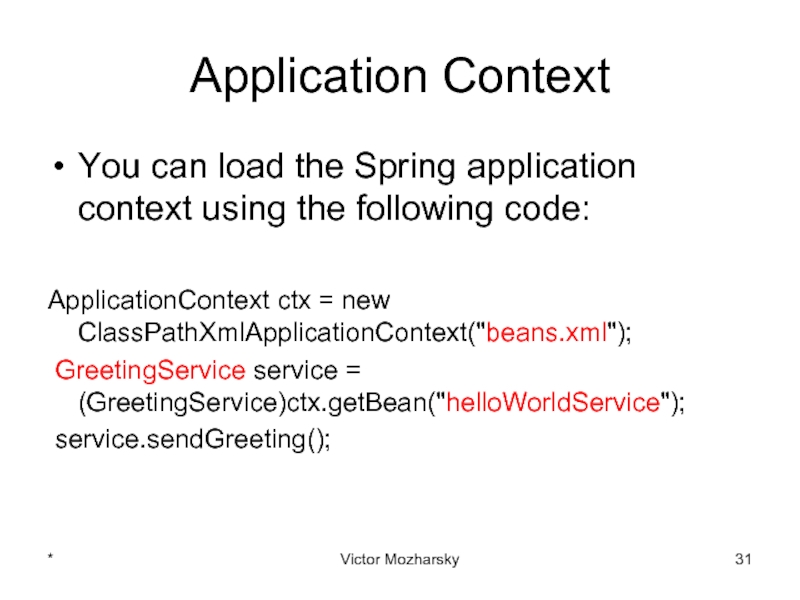
![Example 1. Application Classpackage com.bionic.edu;import org.springframework.context.ApplicationContext;import org.springframework.context.support.ClassPathXmlApplicationContext;public class Application { public static void main(String[]](/img/tmb/2/125298/5860b6d963681a54b3c23f4502aec8a2-800x.jpg)
